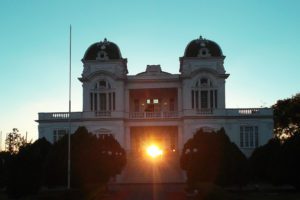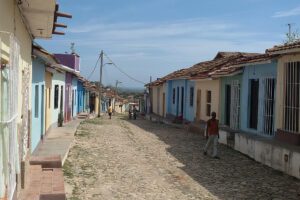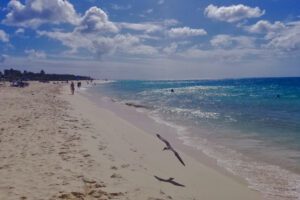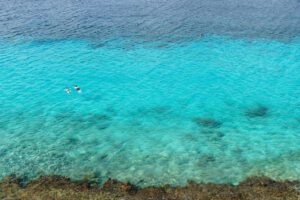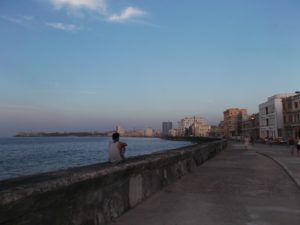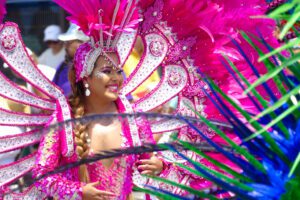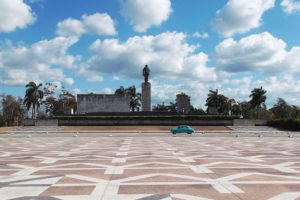Its unique shape of a butterfly makes Guadeloupe one of the most beautiful and outstanding islands in the Caribbean. The fact that it consists of two wings is not only captivating. These two parts, which are only separated by a narrow strait, are also geologically very different. After having introduced the rather laid-back part of Grand Terre in my last post, it’s time to see the best places in Basse Terre, the western wing of Guadeloupe, that you can just as easily visit even by public bus.
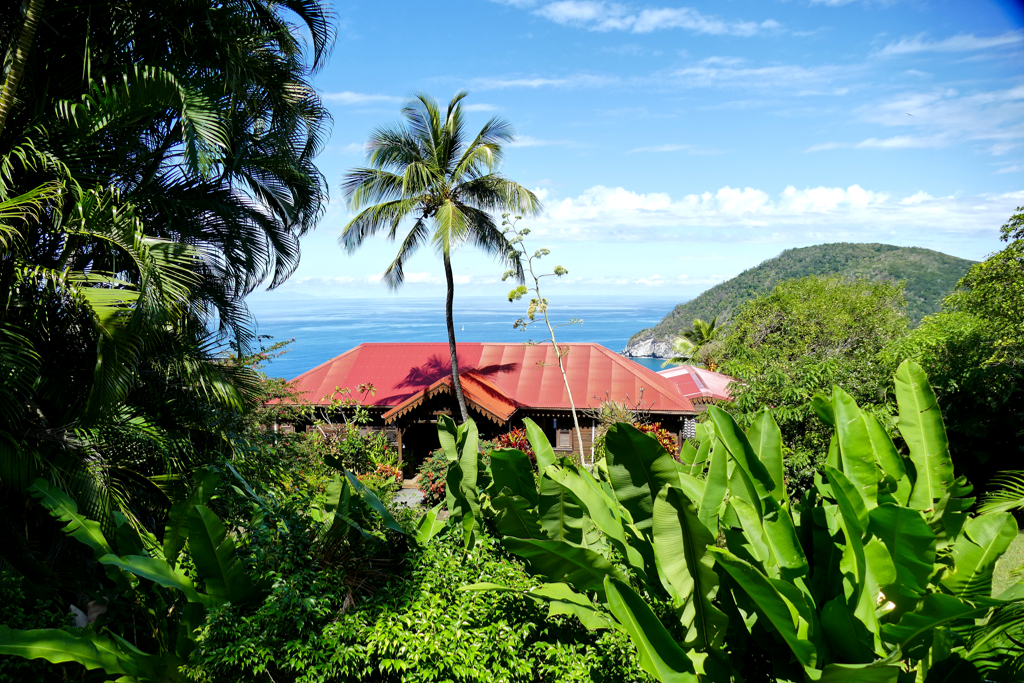
Two Very Different Wings of the Same Butterfly
To be precise, Guadeloupe is an archipelago and not a single island. It is made up of six inhabited and some smaller uninhabited islets. The two main islands are Basse Terre and Grande Terre. They are separated from each other by the narrow Rivière Salée strait. At its narrowest point, it is only about 50 meters wide. In the immediate vicinity of the main islands are the small islets Marie Galante, La Désirade, and the Îles de la Petite Terre as well as the only partially inhabited archipelago of the Îles des Saintes.
The Kalinago, an indigenous people, lived in Guadeloupe when life here – as in the entire region – changed dramatically in the 17th century. That was the time when colonial rulers from France made it to the Caribbean. After gradually exterminating the local populatio, they needed farmhands for their vast sugar cane plantations. Hence, they abducted men and women as forced laborers from the west coast of the African continent in the infamous triangular trade.

For a summary of how Guadeloupe came into being and became what it is today, including its somewhat absurd status as one of France’s 101 departments, see my main post Grand GUADELOUPE: Complete Guide And Perfect Itineraries (also for travels by public bus). There I have also put together all the information and my personal tips. They will make planning your own trip easier so you’ll have even more fun.
But now let’s see what Basse Terre has to offer.
Basse Terre – the Lush Lowland
Guadeloupe’s two main islands Grande Terre in the east and Basse Terre in the west are almost symbolically held together by its capital Pointe-à-Pitre. However, in the very south of the island of Basse Terre is a town that is also called Basse Terre. A little confusing, I know.
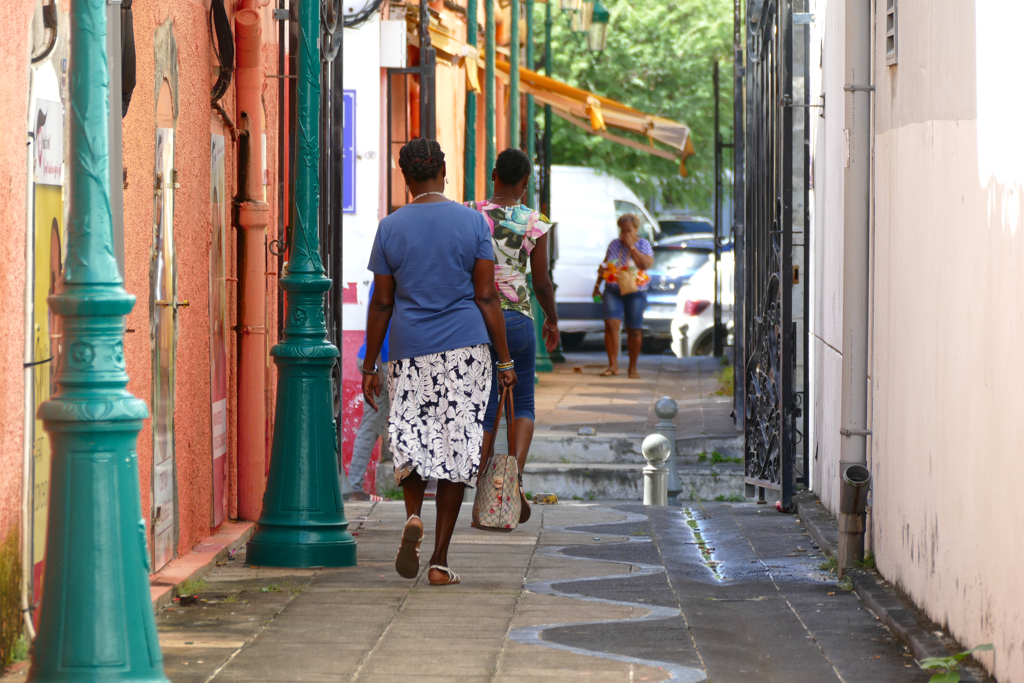
Basse Terre – the island – forms more than half of the archipelago’s entire land surface. Although Grand Terre, which translates to the Large Land, seems to be the more influential part, it’s actually its untamed big sister formed around the volcano La Grande Soufrière that earns Guadeloupe the greatest merits.
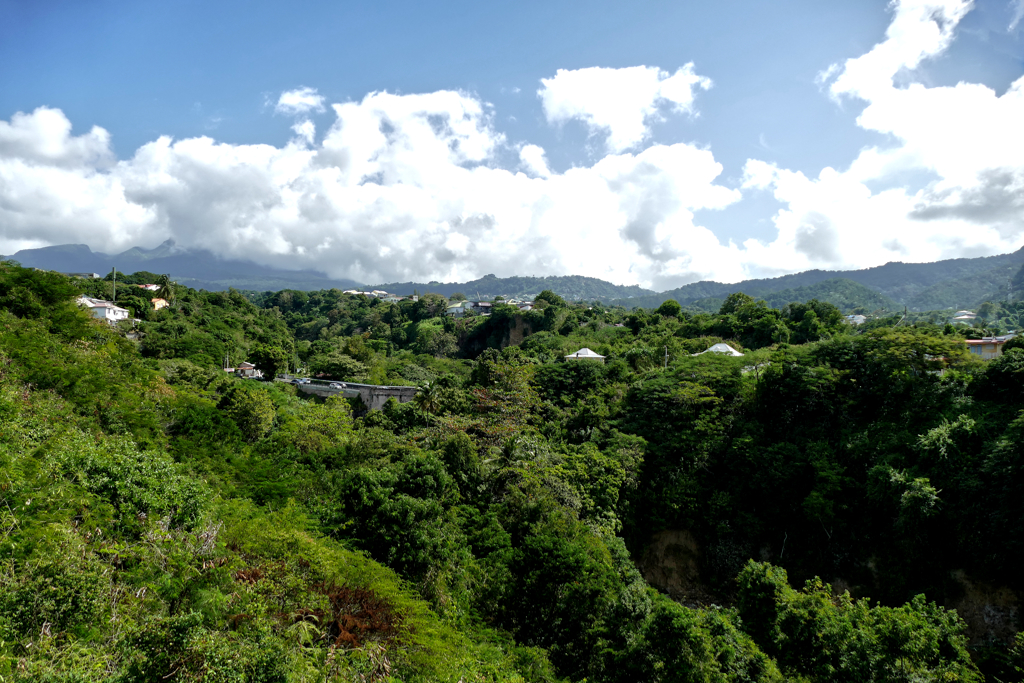
Not only is the volcano the highest mountain peak in the Lesser Antilles and one of nine active volcanoes in this region. The so-called Parc National de la Guadeloupe around its crater is the largest national park in the entire Caribbean. It was officially founded in 1989 and covers an area of around 17,300 hectares. That’s around ten percent of the entire archipelago!
In 1993, UNESCO added the Guadeloupe Archipelago to the world’s biosphere reserves list. The islands provide a habitat for more than 300 species of trees, 270 ferns, and 100 kinds of orchids. 38 species of birds are flying around and 17 species of mammals are frolicking in the undergrowth.
On the Road Again
“No, don’t get on yet”, says the tall and very chubby bus driver. “The bus doesn’t leave until 8:15”. Then he closes the bus door by pressing a button and jokingly joins a group of men hanging out at the bus station in the morning. Whether they are here just for fun or whether they actually have something to de is unclear.
What’s quite clear is that the young woman who is sitting on one of the simple benches and eating a sandwich for breakfast wants to go. Every now and then she takes a sip of her Fanta. An old, very thin lady has now sat down next to her. She has her gray hair in what must have been dozens of very short braids. In her colorful skirt and equally colorful yet totally differently patterned blouse she looks like out of some tropical movie.
After the tall and very chubby bus driver has lifted the old lady’s shopping cart into the trunk of the bus, he climbs onto the driver’s seat and shouts to us that we can get started.
First, a young father gets on board with his teenage daughter. With his tight jeans, the black T-shirt, and the dreadlocks that he has tamed under a huge hood, he could actually be her older brother. The bus appears to be fairly new and is in immaculate condition. Not even the protecting clear plastic covers were removed from the seats. That may be good for the seat covers, but for me it’s horrible. I’m wearing shorts and my bare legs are instantly stuck to the plastic.
Going Public
This is by no means my first ride on a public bus since I’ve been in Guadeloupe. I don’t drive and therefore rely on public transport. According to my experience, it mostly works like a charm. The buses are on time – and often over-punctual, meaning up to 15 minutes early. But I’ve gotten used to that by now. I just make sure to be at the bus stop 20 minutes before the scheduled departure. Unfortunately, they don’t go that often, hence, I don’t want to take any chances.
I silently count and conclude that today is my sixth major tour by public bus. I’m based in Sainte Anne, a small town roughly in the middle of the south coast of Grande Terre. Since most long-distance routes start at the Bergevin bus terminal in Pointe-à-Pitre, this means that I first have to take a Karu’lis bus from Sainte-Anne to the capital. Depending on traffic, this takes around 45 to 60 minutes. Once in Pointe-à-Pitre, I need to walk for around 20 minutes to the Bergevin neighborhood where I then wait for my connecting bus.
As the morning traffic is unpredictable, I often get to Bergevin so early that I even catch a bus before the one I was actually planning for. Same today: I had planned for the bus at 8:45, but now I’m sitting on the earlier one.
That’s all right with me: All the more time to explore the unexpectedly lovely town of Basse Terre!
Basse Terre – a Bustling City
And it turns out that it was a really good plan as Guadeloupe’s second-largest city is very charming and pretty. It’s right by the sea and seems to be quite artsy. I like that.
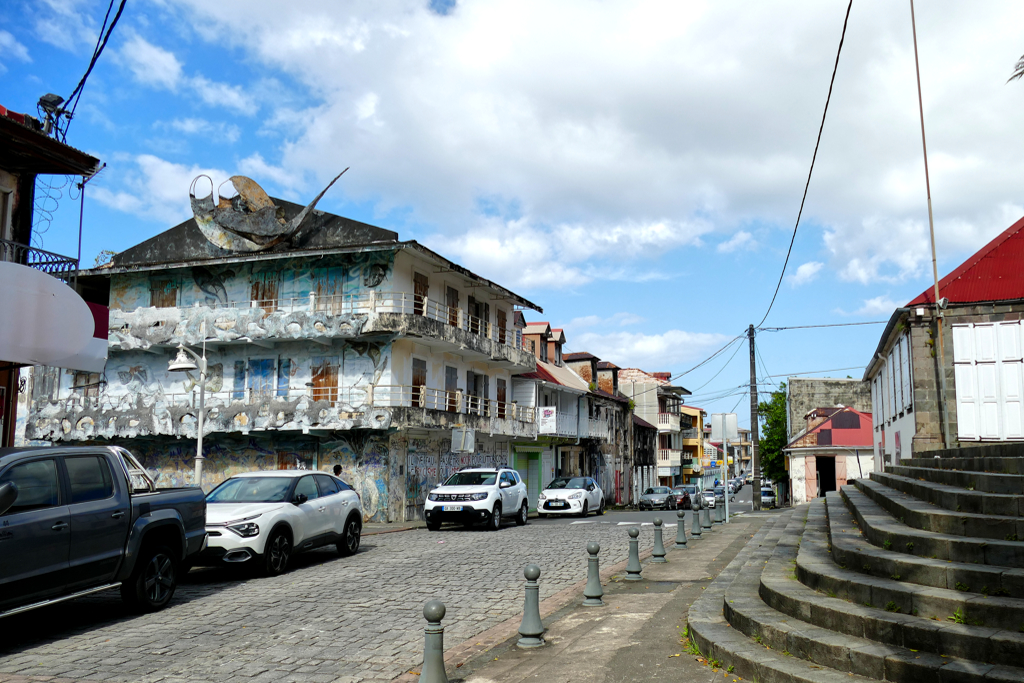
Appointed governor Charles Houël built a stronghold for trade in 1650. Eventually, friars constructed first the church Notre Dame du Mont Carmel and then Cathédrale Notre-Dame de Guadeloupe. The town developed around those places of worship throughout the 17th and 18th centuries. Step by step, the Basse Terre flourished and became the administrative and economic center of the island over the course of the 19th century.
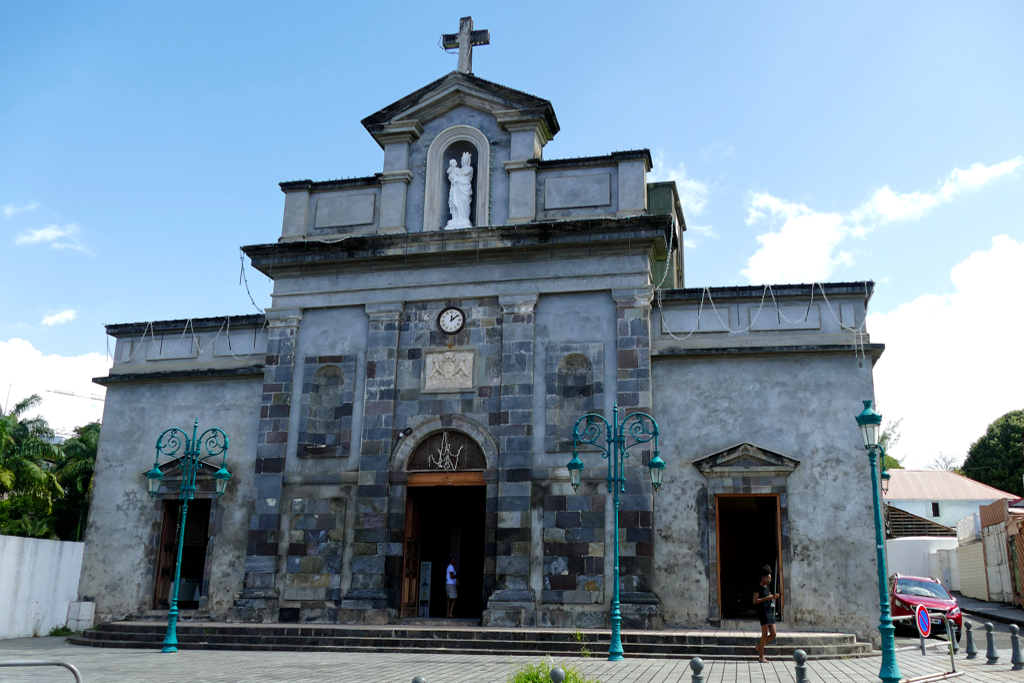
However, as Basse Terre was affected by various destructive cyclones and was also under constant threat of the eruption of the Soufrière volcano, it lost its status to Pointe-à-Pitre. However, some administrative and judicial authorities remained.
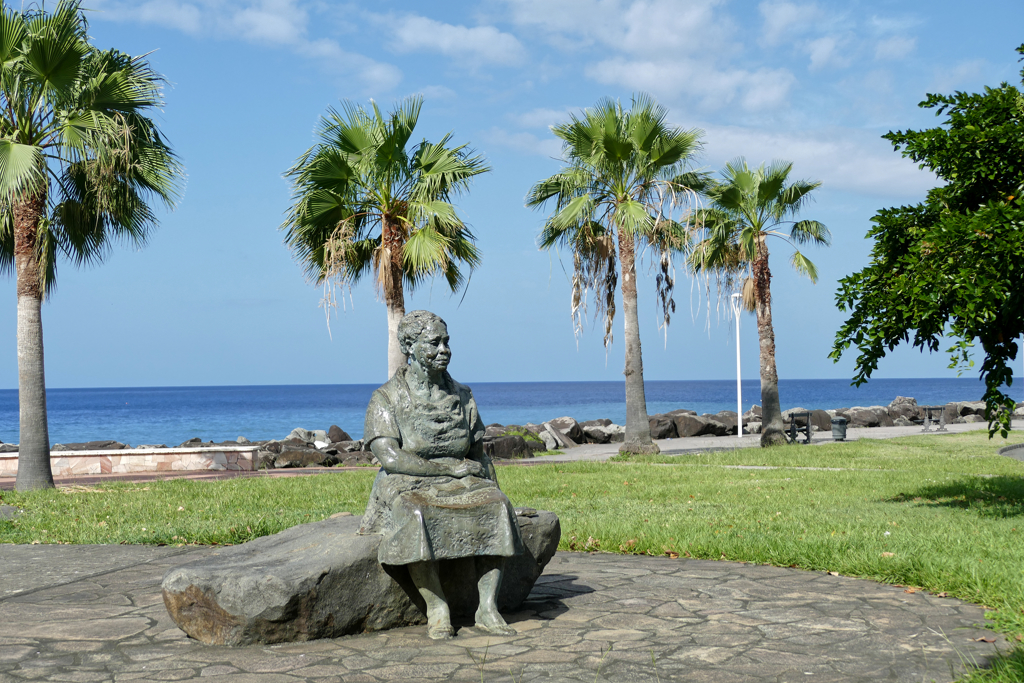
Also, the city kept its status as the capital of the province. As the mountainous terrain doesn’t allow large-scale agricultural cultivation, the rum distillery Bologne is actually one of the very few notable companies. It lies about two kilometers north of the city center and offers guided tourist visits.
To improve Basse Terre’s economy, a ferry terminal was opened in 2015.
Fort Delgrès
As my bus arrives at Basse Terre’s terminal, I see on the map that Fort Delgrès is less than a 15-minute walk away. It’s only ten o’clock and the sun is already burning. So hopefully, the climb to the fort isn’t too steep.
The construction of the former Fort Saint Charles in the mid-17th century marked the actual birth of Basse Terre. In the beginning, its main purpose was to defend the island against British conquest. Nevertheless, the Brits managed to occupy the archipelago in 1759 but lasted only for four years. It then went back to the French.

In 1794, slavery was abolished in Guadeloupe. Yet, Napoléon had this crazy idea to re-establish it in 1802. But his henchmen had not expected the dogged resistance of the men around Delgrès and Ignace. Sadly, they lost the battle. The following year, Napoléon ordered to name the bastion after his general Antoine Richepans.
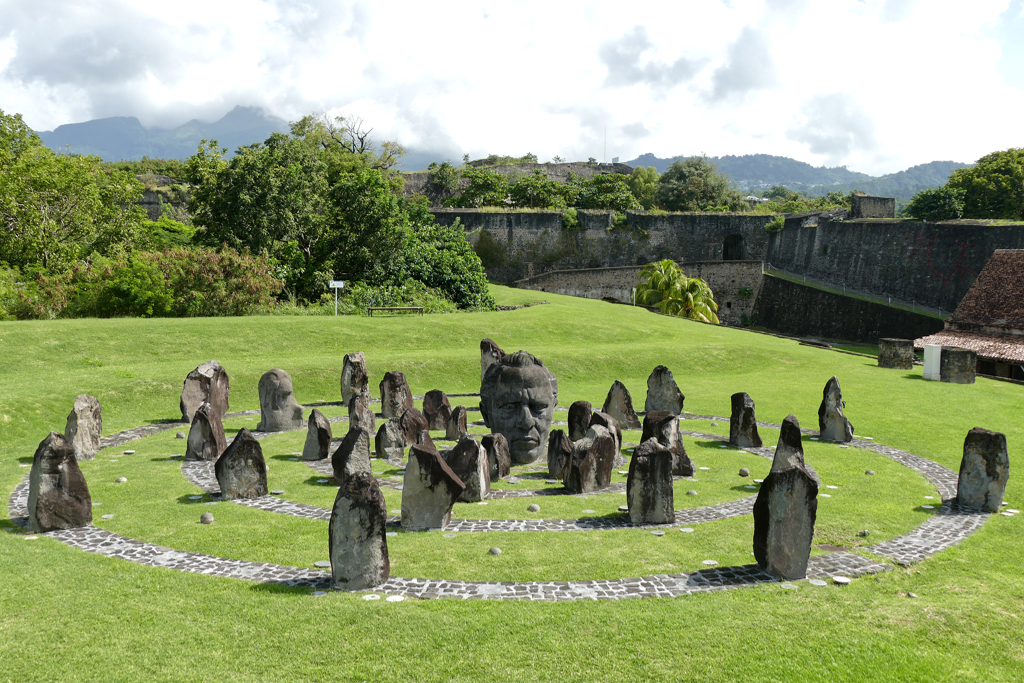
Only in 1989, to honor the merits of Louis Delgrès, it was finally renamed after this great freedom fighter.
Today, this historic place can be visited from Tuesday to Friday between 9 a.m. and 4.30 p.m. On weekends, they open only at 9.30 a.m. The visit is free of charge.
Unexpected Guides
On the way back from the fort towards the city center I see posters on the wall of a school. They are photos of outstanding sites in Basse Terre. Students of Lycée Gerville-Réachewere had to pick a place in the city that they think is particularly meaningful for whatever reason and photograph it. Next to their wonderful photos are small signs with brief explanations of what makes these places special for these young artists.
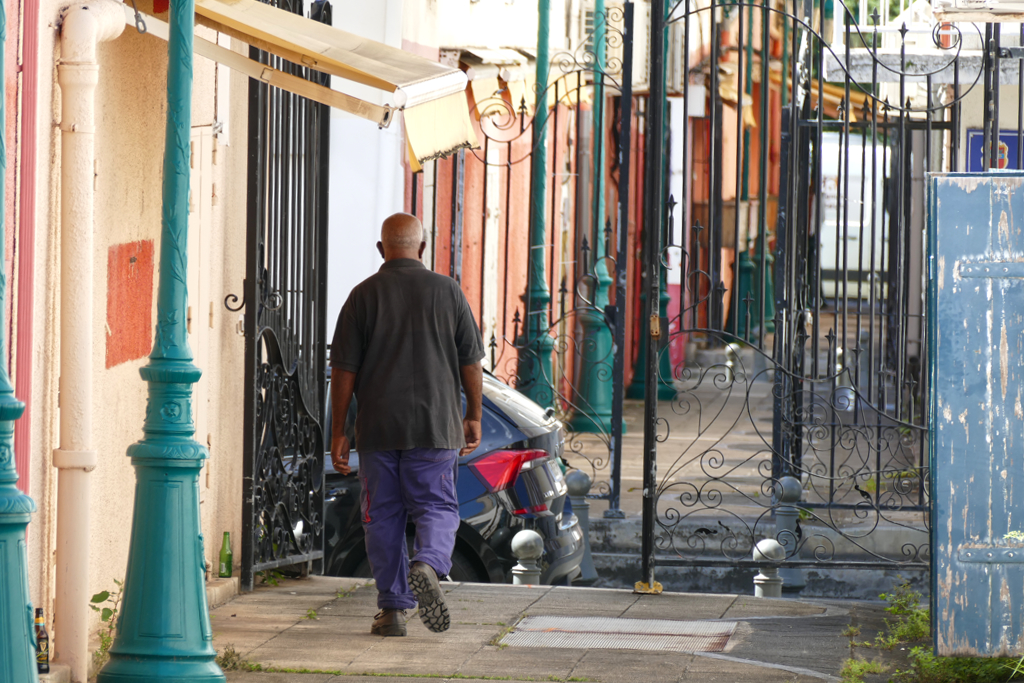
On the one hand, I think this project is great because it inspires these young citizens to recognize the value of their own city. And for me as a visitor, it’s great information about what else I could see besides the most famous landmarks like the fort, the Notre Dame du Mont Carmel church, and the old market hall.
More Landmarks
In the photo above you can see the picturesque Cicéron passage. It was recently renovated and saved from complete destruction. Unfortunately, not all historical buildings in Basse Terre are granted this privilege. During my tour of Pointe-à-Pitre, I was horrified to see the beautiful old colonial buildings in such a dilapidated condition.
Sadly, in Basse Terre, they don’t look much better.
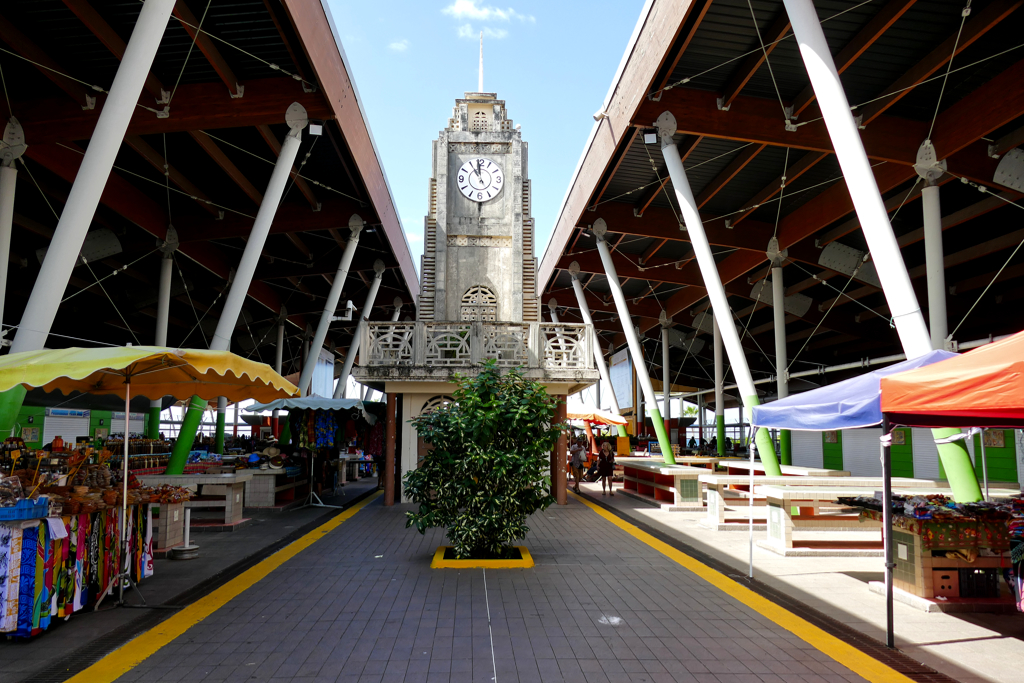
Supposedly, the city’s half-covered market is the largest in Basse Terre. It is held from Monday to Saturday between 6 a.m. and 2 p.m.
Maybe I’m simply not the right person to ask since I’m not so crazy about markets in general. However, just like many other markets on the island, I found Basse Terre’s market far too touristy. Yes, some vendors also sell local fresh produce. Yet, most of the stuff is regional preserves, punches, and the ubiquitous Madras checkered trinkets.
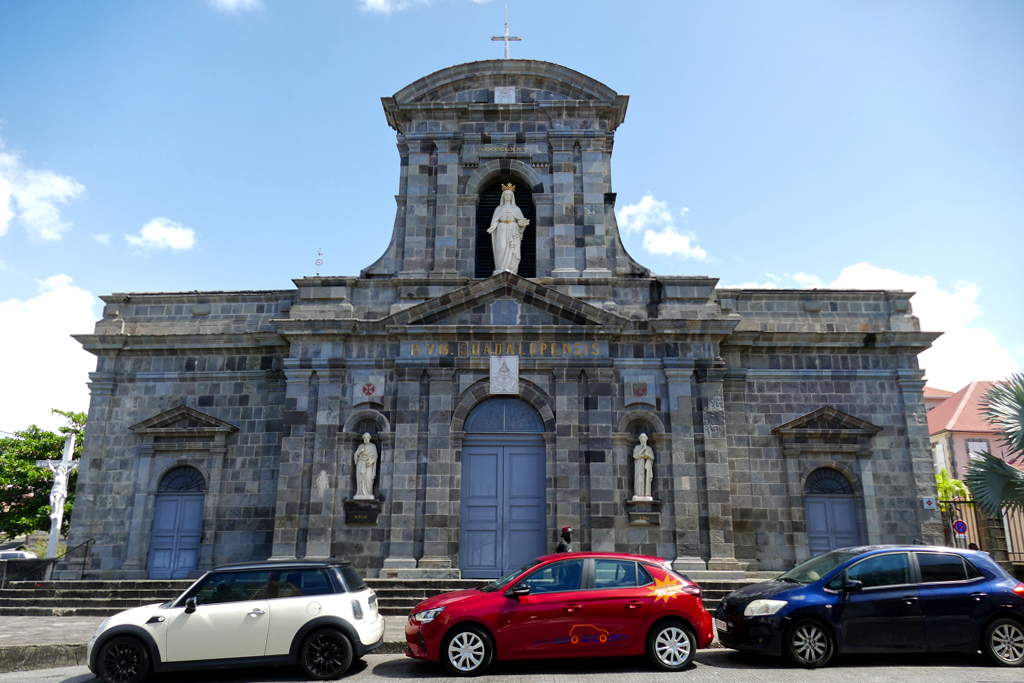
The Notre Dame de Guadalupe Cathedral is one of the city’s most important landmarks. In the 17th century, the first building on the property went to the Capuchin monks. It was a chapel with an attached monastery dedicated to Francis of Assisi. Today’s cathedral was first constructed in 1736. Interestingly, its facade is made of volcanic stones and decorated with statues of Saint Peter, Saint Paul, and the Virgin Mary.
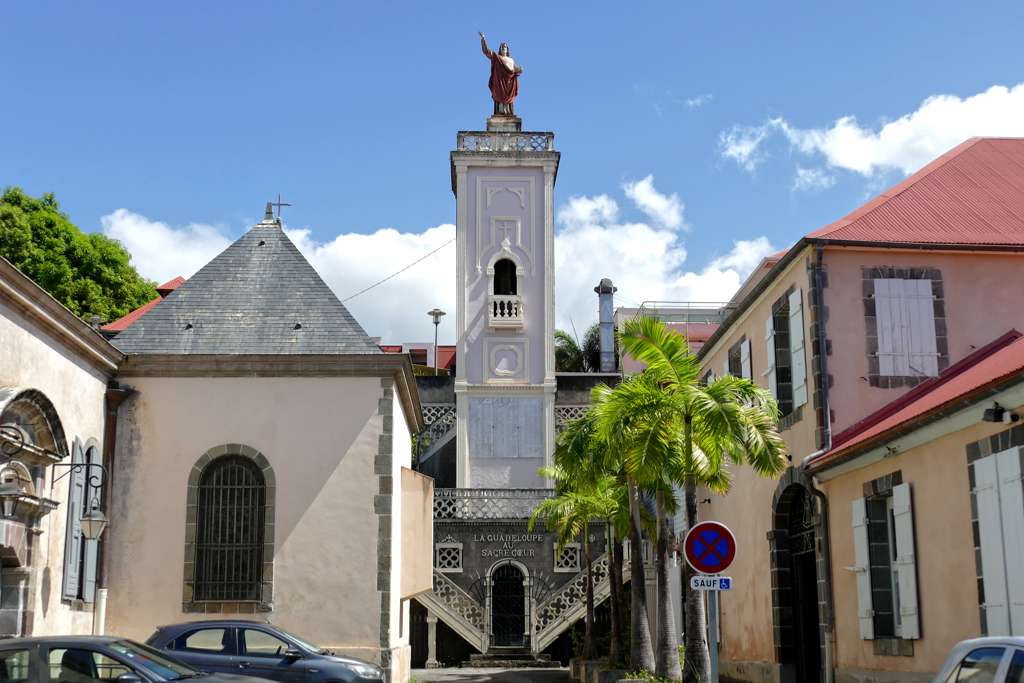
The Real Life
Basse Terre is generally a little less run down than Pointe-à-Pitre. On the whole, however, it can be said that the towns and cities in Guadeloupe are nothing to write home about.
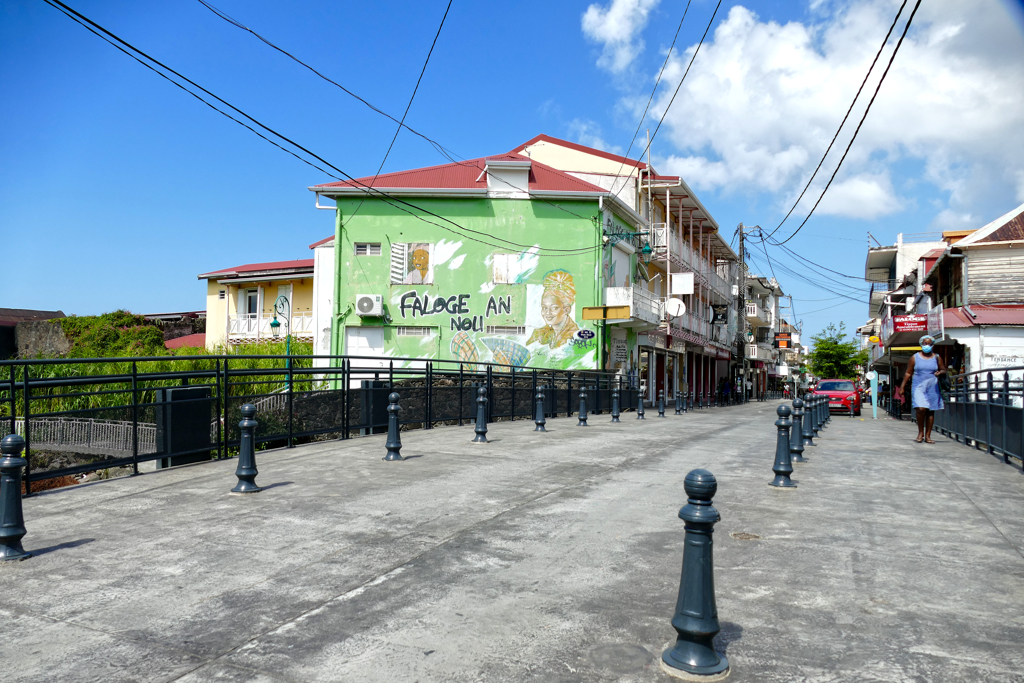
Not only that there are almost no memorable landmarks that you absolutely have to see. Many buildings are in very poor condition, and streets and squares tend to be empty. People don’t seem to hang out outside that much.
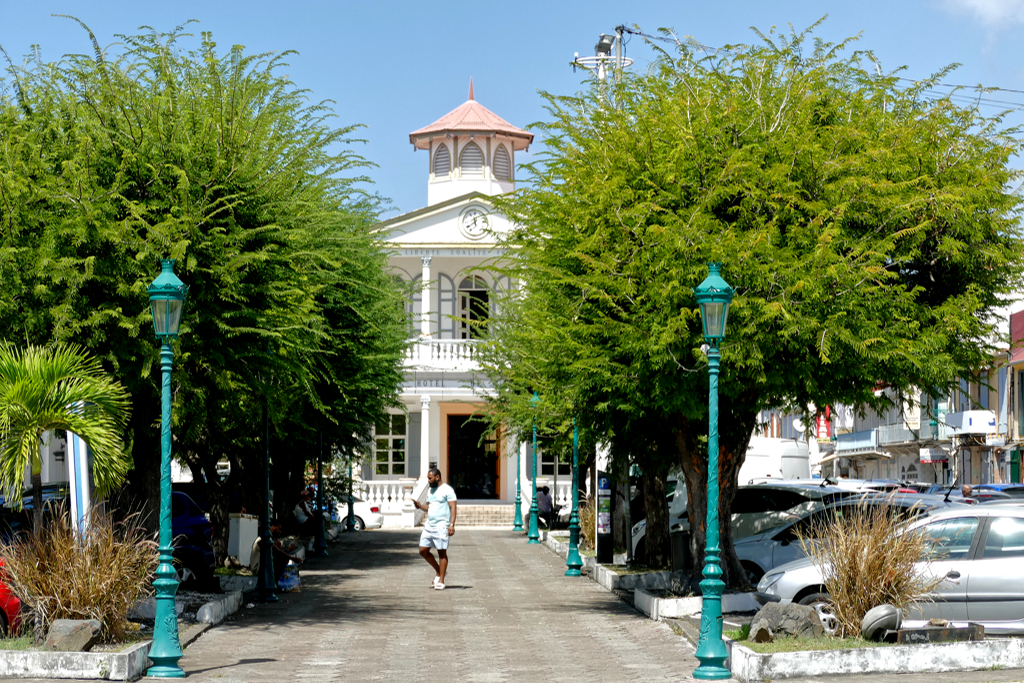
Yes, you’ll see locals running errands, obviously, but there’s not a particularly relaxed or even cheerful vibe. It all feels a bit uninspired and tired and listless. I’m not saying the cities are ugly, they just aren’t notably picturesque or charming.
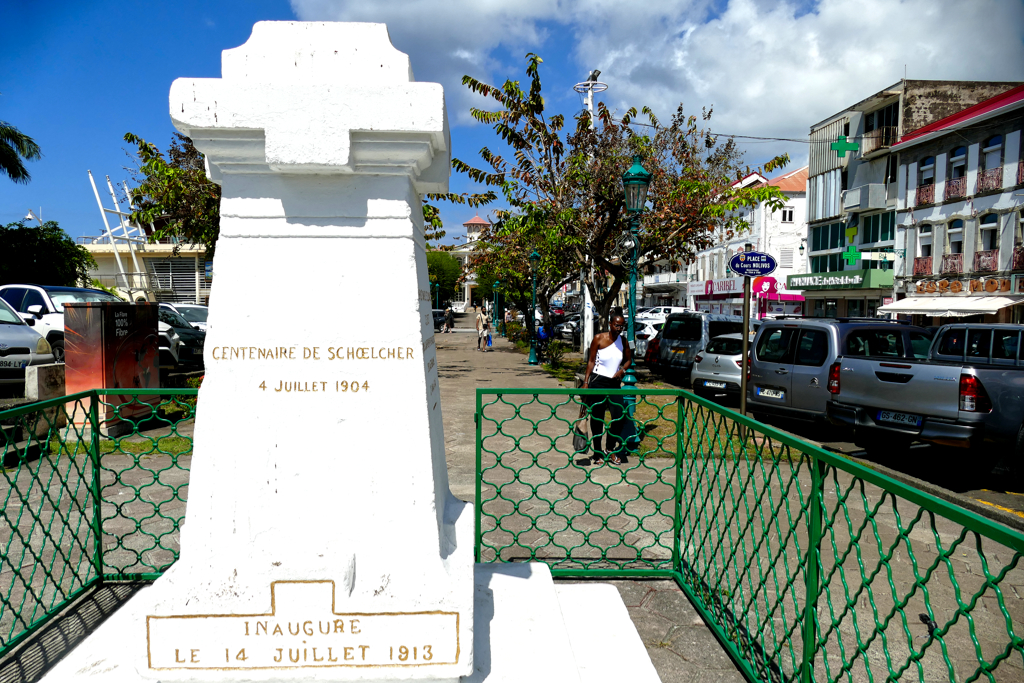
Guadeloupe clearly scores with its rural areas, its breathtakingly dense tropical landscape, and the light golden beaches along the clear waters.
Route de la Traversée
It’s easy to get from Pointe-à-Pitre to Basse Terre by bus. Coach #105 leaves Bergevin every half an hour between 5.30 a.m. and 6.30 p.m. However, it takes almost one and a half hours for the route as the bus goes down the entire east coast of Basse Terre. Never mind: I see public bus rides as nothing but a very inexpensive scenic drive. But one mustn’t forget that I’m on vacation. Locals certainly find this long trip much less captivating.
For those in a rush, the so-called Route de la Traversée was built in 1967. To this date, it is the only road crossing the island of Basse Terre in a straight line from east to west for 17 kilometers cutting through the mountain range and the Guadeloupe National Park. Along this route are also some pretty amazing sites like the zoo, the iconic waterfalls, and the Maison de la Forêt. This so-called forest cabin houses an exhibition on the rainforest. You can drop in every day between 9 a.m. and 4.30 p.m. On Sundays, they are closing already at 12.30 p.m.
The cabin is also the gateway into the National Park. There are routes of different lengths and difficulties. However, it’s a forest, not an English garden. Therefore, paths are rocky, wet, and in some spots muddy. Also, the high humidity makes hiking more strenuous.
Actually, it’s not due to the lack of public transport that I didn’t go on hikes to the island’s famous waterfalls. In fact, you always have the option to get off near a hiking trail that leads to the falls. My reason was that after my horrific accident in Gran Canaria, I no longer roam alone in unknown territories. This way, I unfortunately missed out on a significant part of Guadeloupe’s beauty.
Pointe Noir – Where Wild Nature is the New Black
Driving down the Route de la Traversée, you’ll reach Basse Terre’s west coast six kilometers south of Pointe Noir.
The Battle of Pointe Noire took place in 1809 and I believe that was the last time anything exciting happened here. Albeit, the construction of the Route de la Traversée in 1967 made Basse Terre’s west coast much more easily accessible from the economic center of Pointe-à-Pitre than before. Obviously, a place as remote as Pointe Noire also benefited from this.
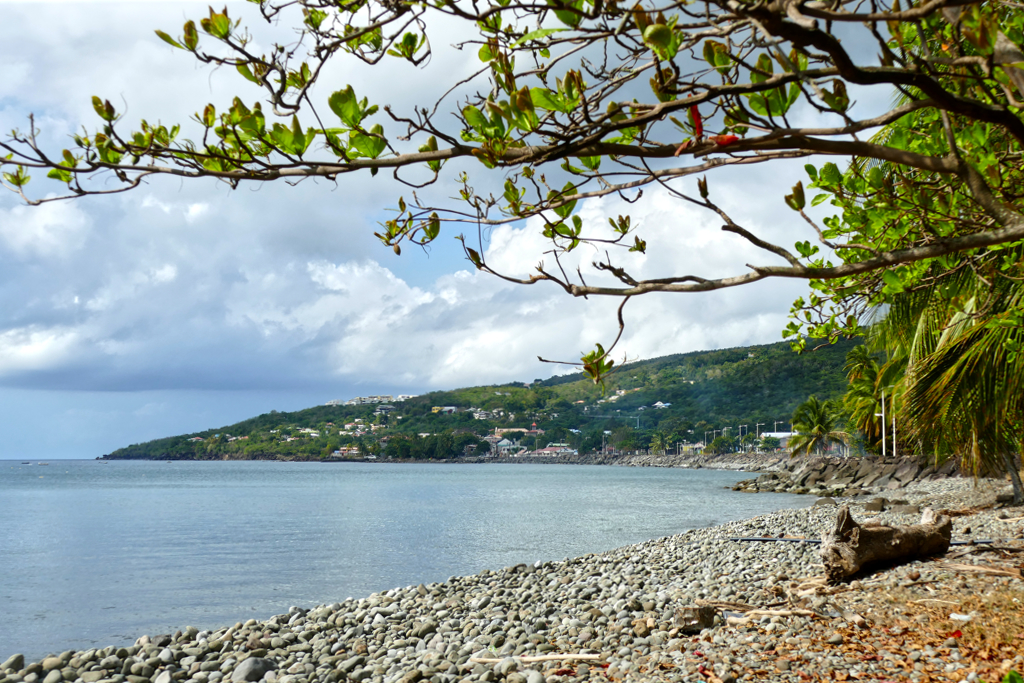
Pointe Noire has always been a community whose main income depended on timber. It has also been an agricultural region known for its cocoa and coffee. The Beauséjour coffee plantation is still located here. By the way, coffee made in Guadeloupe tastes absolutely delicious. My favorite brand is Café Chaulet, though.
Also, fishing remains an important economic sector. After all, the city is located right on the coast. Obviously, there are beaches nearby, the closest ones being Petite Anse south of town.
Apart from the Beauséjour coffee plantation, you can also visit the fun La Maison Du Cacao and the Maison du Bois, better known as Habitation Côte Sous le Vent.
In short: Like so many other places in Guadeloupe, Pointe Noir, which by the way translates to black point, impresses rather with its surroundings.
Habitation Côte Sous le Vent
Now, the Habitation Côte Sous le Vent is a very short walk south of Pointe Noire. It is a mix of a botanical garden and a museum.
The outdoor area and exhibitions at Habitation Côte-sous-le-Vent are dedicated to the region around Pointe Noir, which is in many ways considered the breadbasket of Guadeloupe. Pointe-Noire is the cradle of wood craftsmen and centuries-old traditions of the Antilles.
In the densely overgrown arboretum, you will find trees that are centuries old. Educational boards provide information about all the little wonders nature has in store. You can see how cocoa, coffee, and spices grow and also enjoy beautiful orchids, bromeliads, and blooming bushes.
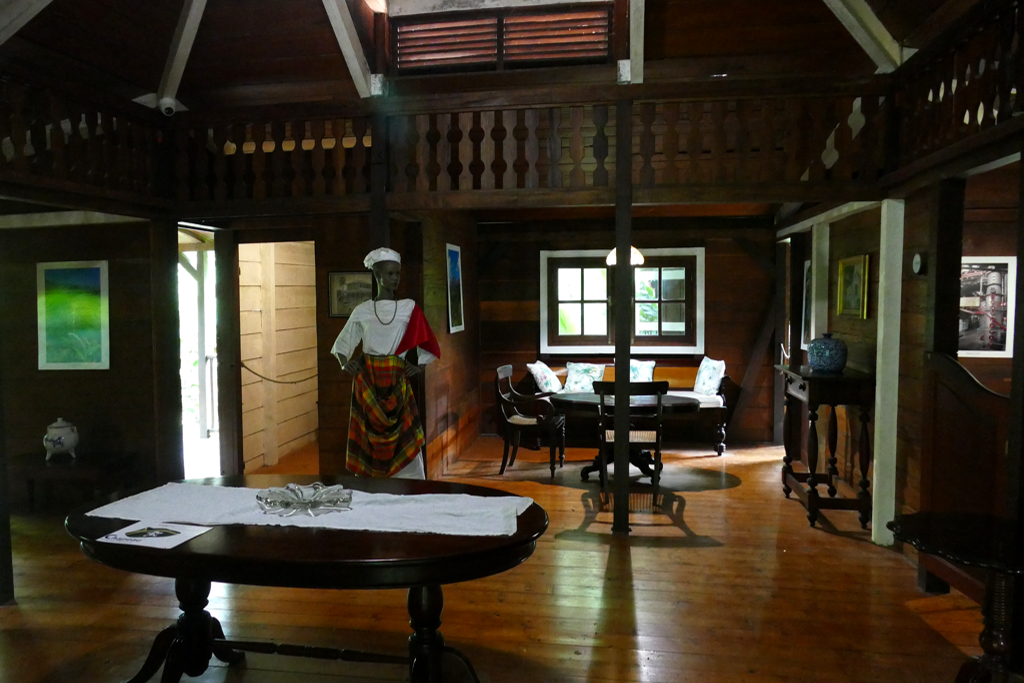
In a typical Creole home, you can see how the people in the region used to live. In small workshops, it is explained how work was traditionally done in the regional wood industry and in crafts.
Another exhibition takes you into the world of piracy. After all, the region was a hotbed of buccaneers in the 17th century!
I would especially recommend the visit to families with kids. Here they will learn a lot about different aspects of the Caribbean in a highly entertaining way. Also, plan your visit for several hours. In addition to the compelling exhibitions, kids can explore the outdoor area and play to their heart’s content. Since there are tables and benches in the garden, you can then have a cozy family picnic in this beautiful setting.
Habitation Côte Sous le Vent is open from Wednesday to Sunday between 10 a.m. and 5 p.m. The general entrance fee is 9.50 €uros.
Parc Aquacole
When I saw this park online, I didn’t fully understand what it was. That made me curious. Since it’s only a fifteen-minute walk from the Maison du Bois, I thought why not give it a try?
Was it worth it? Yeah.
Is it a must? Nope.
But what exactly is it?
Basically, it is an ecological water reserve. It consists of ten ponds where fish such as Caribbean sea bass and red mullet are bred and kept. There are trees and bushes around the pools that provide an idyllic refuge for protected bird species such as ospreys, kingfishers, and egrets.
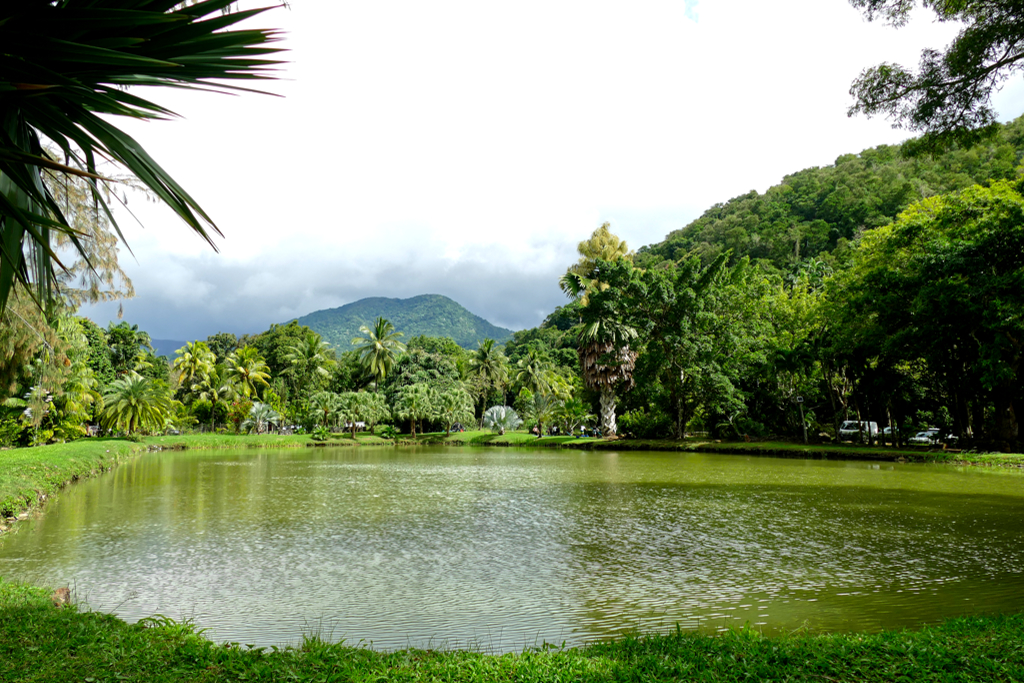
You can walk around on almost 2.5 hectares of ground and enjoy nature and, above all, the unbelievable tranquility. Small signs about the species make the walk an inspiring educational trail, especially for kids. On Fridays and Sundays at 11 a.m., you can also join a guided tour with a biologist to learn all about aquaculture, its challenges, and its problems.
By the way, you can rent a fishing rod and fish in the pools. In the end, you pay for your catch, which is guaranteed to be free of drugs and environmental toxins, according to its weight.
Occasionally the snack bar offers small dishes made from fresh local products.
Just a self-guided tour costs 3 €uros.
Deshaies – as Seen on TV
As soon as the bus turned into Deshaies, I was taken aback by its charm. Surrounded by lush hills, this small fishing village with its colorful wooden houses, swaying palm trees, and laid-back vibes is just the epitome of the Caribbean.
You know, I really think this could be an excellent backdrop for a movie or a show set in the tropics.
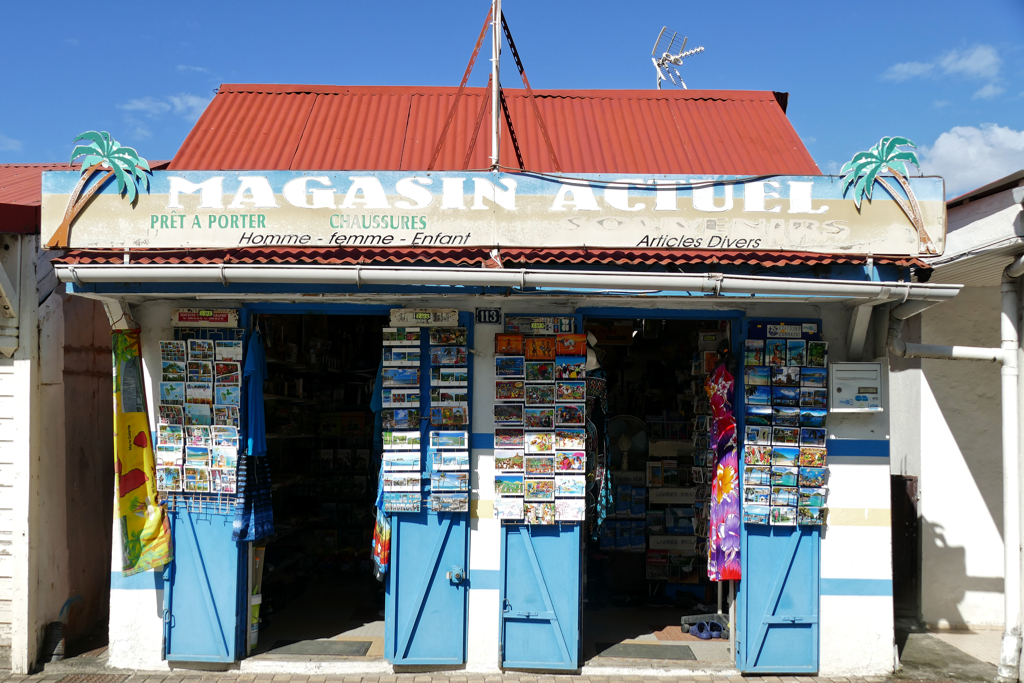
Oh wait, that’s what it actually is. The British-French crime comedy Death in Paradise is filmed right here in Deshaies. Nevertheless, in the series, whose 12th season aired in 2023, the enchanting tropical scenery goes by the name of Saint Marie.
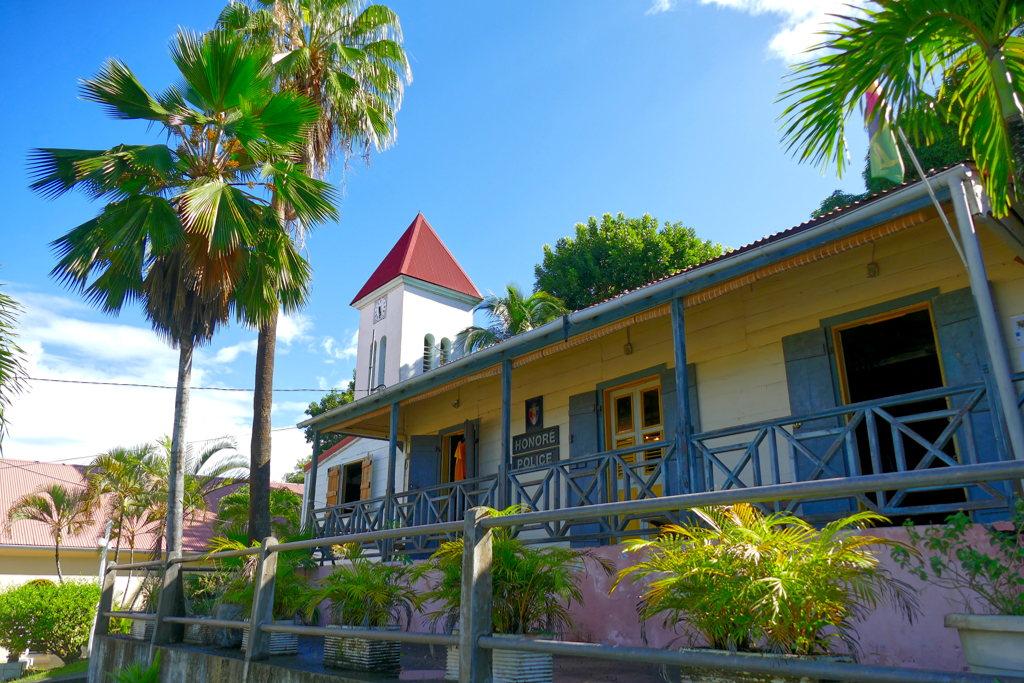
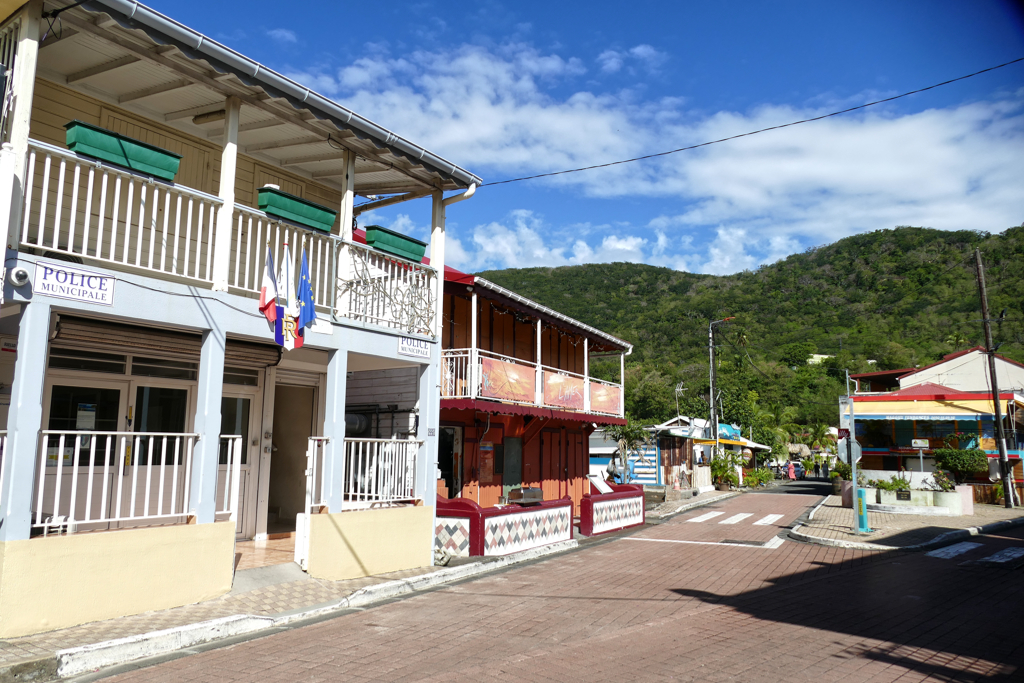
The show is a huge success not only in the United Kingdom and France, but also in the USA, Canada, and even in New Zealand and Australia. Therefore, there are actually themed excursions to the original filming locations.
Paradise, Indeed
Admittedly, it was Death in Paradise that drew me to Deshaies. But not because I think the series is so great. In fact, I find it repetitive and boring. As if that weren’t enough, what’s really aggravating is the subtle racism. Just like in the good horrible old days, a savvy white guy is sent to a banana republic to help the botched and outlandish natives. The way he explains at the end of each episode how he came up with the solution to the case while his little black helpers look at him in speechless admiration exceeds the limit of what I can bear.
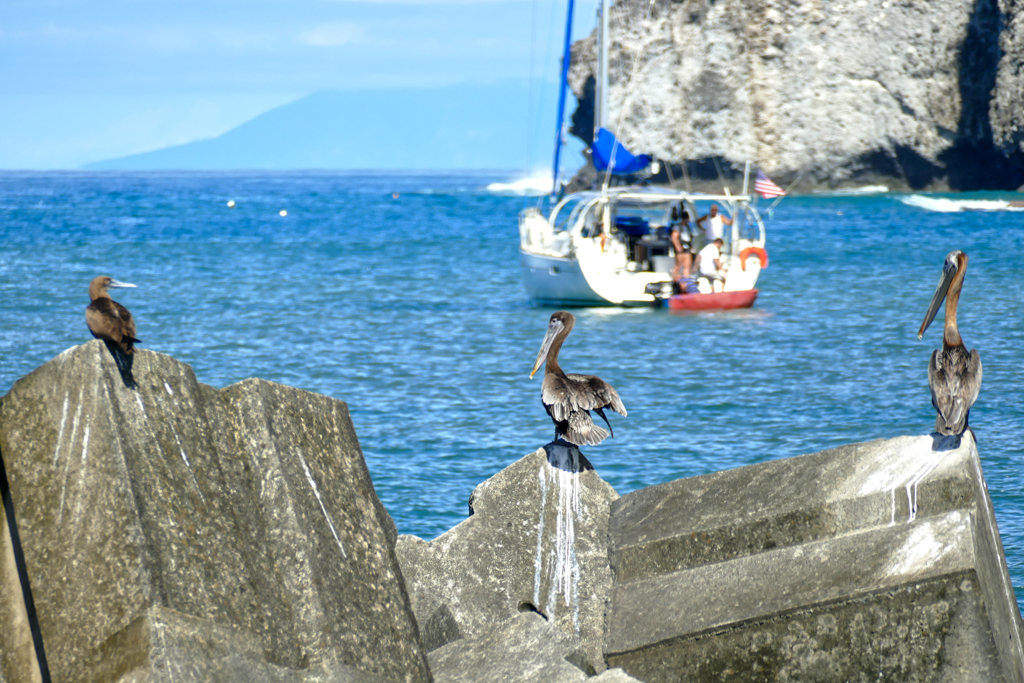
I think I have made it clear that it is not the exciting plot that made me come to Deshaies, but the enchanting setting. And it doesn’t disappoint in reality either. Colorful wooden houses line two narrow main streets interspersed with alleys. The fact that the stores’ offerings are primarily aimed at tourists is not a problem. Bars and restaurants are lined up right next to the shore. To the south is a small fishing port that caters also to excursion boats.
Everything is quiet and idyllic and dreamy.
Jardin Botanique
Apart from a fake police station, the Jardin Botanique de Deshaies is the town’s most iconic landmark.
By the way and since the name is so easy to butcher: Deshaies is pronounced Dé-é.
Although Deshaies’ botanic garden is by far not the only one on the island, it is the most beautiful and most popular one. It’s conveniently located just about two kilometers east of the town center, hence in a theoretically walkable distance.
Did I walk it?
Yes, I did.
Do I recommend doing it?
No, I don’t.
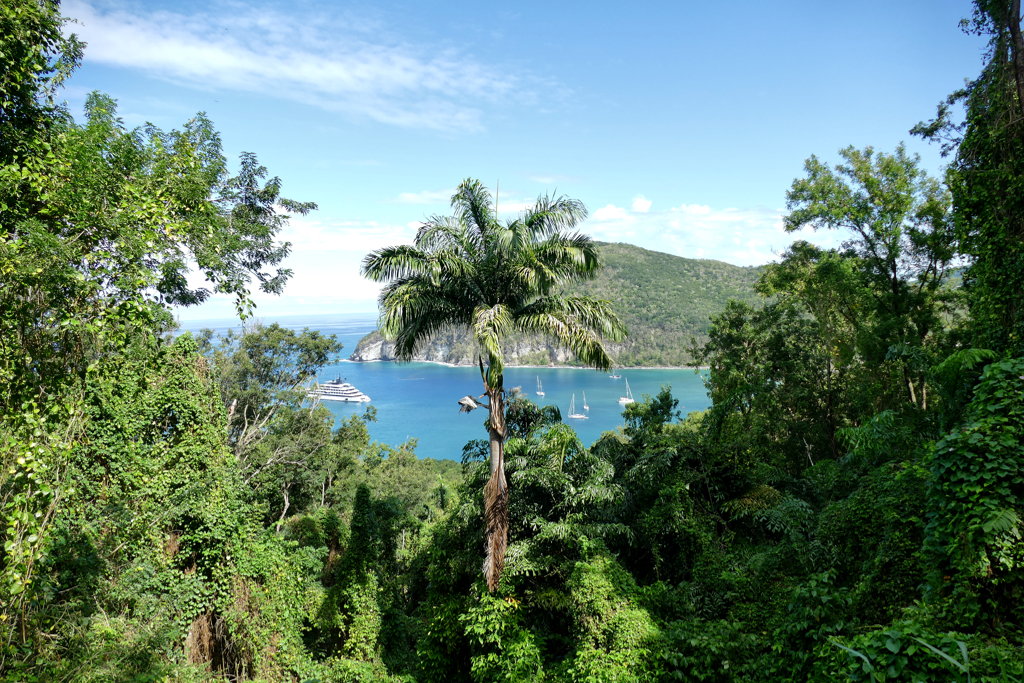
Firstly, you have to walk almost the entire two kilometers up a hill with a gradient of ten percent. In the tropical heat, that’s quite a challenge. What’s much worse, though, is that you’re walking along a very winding road the whole time. Although there are separate pedestrian strips on both sides of the road – which are by no means real sidewalks – drivers do not expect pedestrians and cut the curves. I’d say it’s really dangerous.
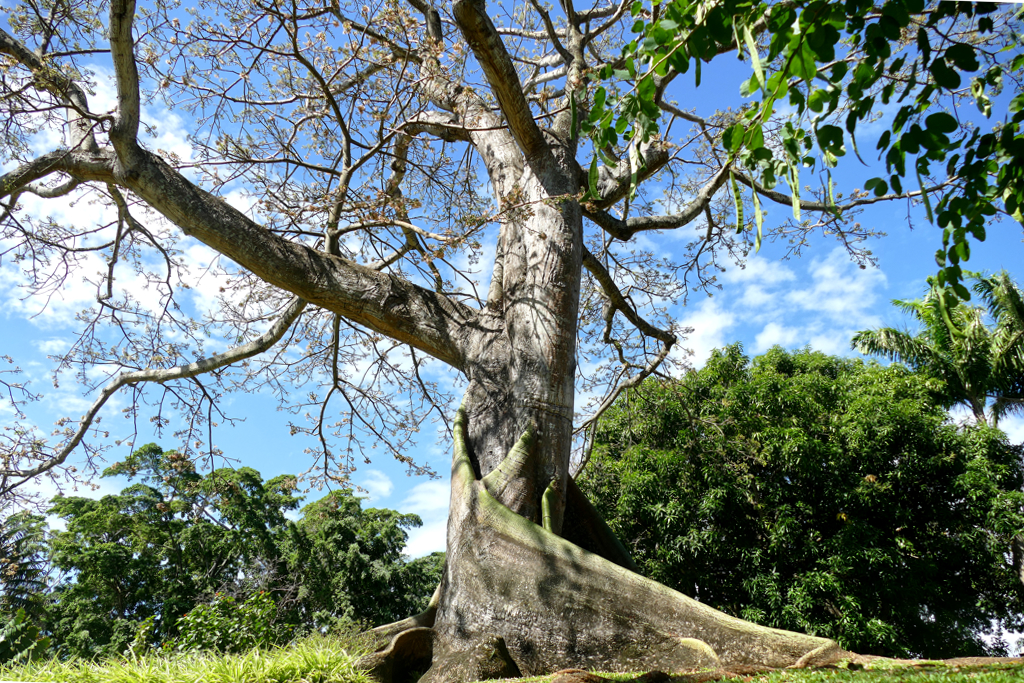
If you’re lucky, you can get to the Botanic Garden from the center of Deshaies by public bus #113. However, this is one of the buses that only runs a few times a day, about every two hours.
So if that’s too inconvenient, you can always take a cab, it’s only two kilometers, hence, the fare shouldn’t be too expensive.
Building Paradise
Passionate horticulturist Guy Blandin set up this little piece of paradise with some rare plants. In 1979, French comedian Coluche bought the property
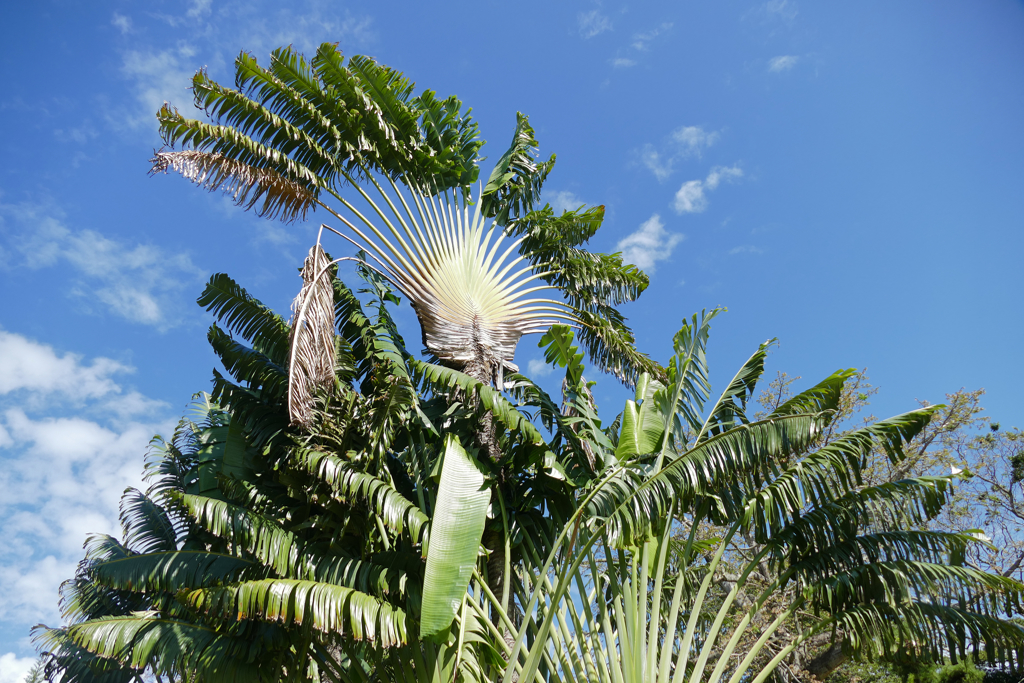
Coluche asked his friend, the landscape designer Michel Gaillard, to look after the property. In return, he allowed Gaillard to set up a palm nursery there. Sadly, Coluche passed away in 1986.
Michel Gaillard, who was familiar with the property, bought it in 1991 and took on the enormous challenge of transforming it into a botanical garden. The five-hectare garden opened in 2001.
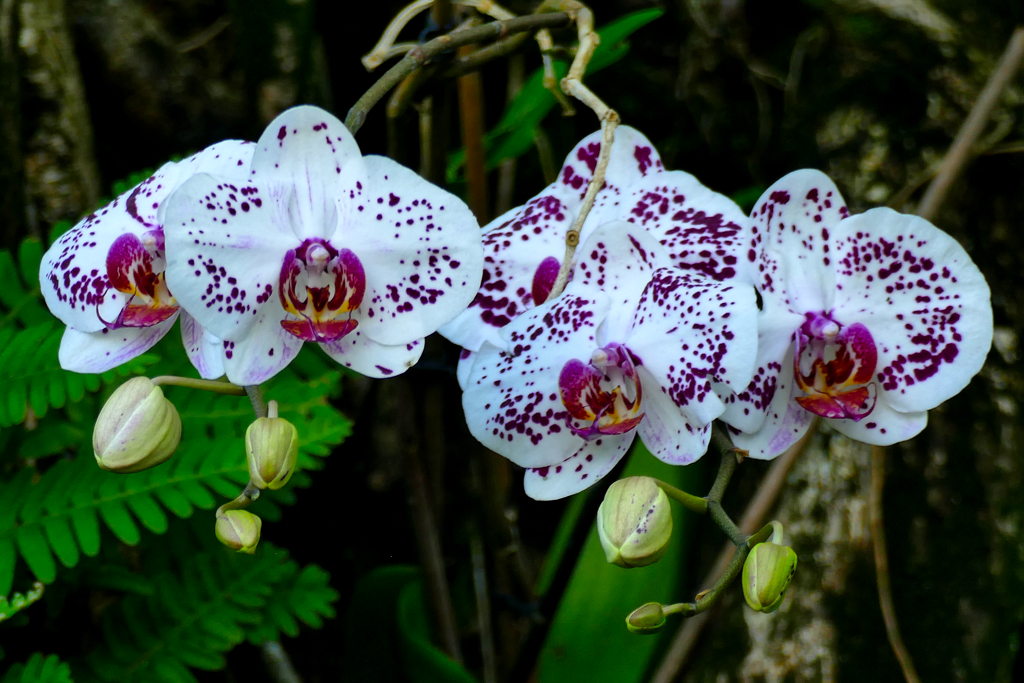
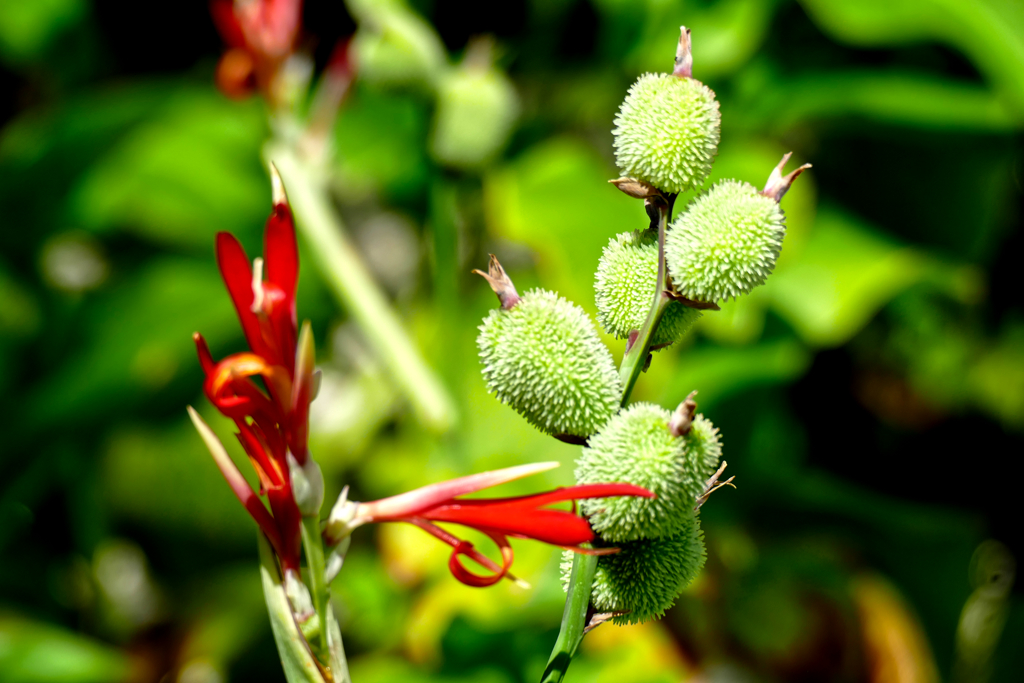
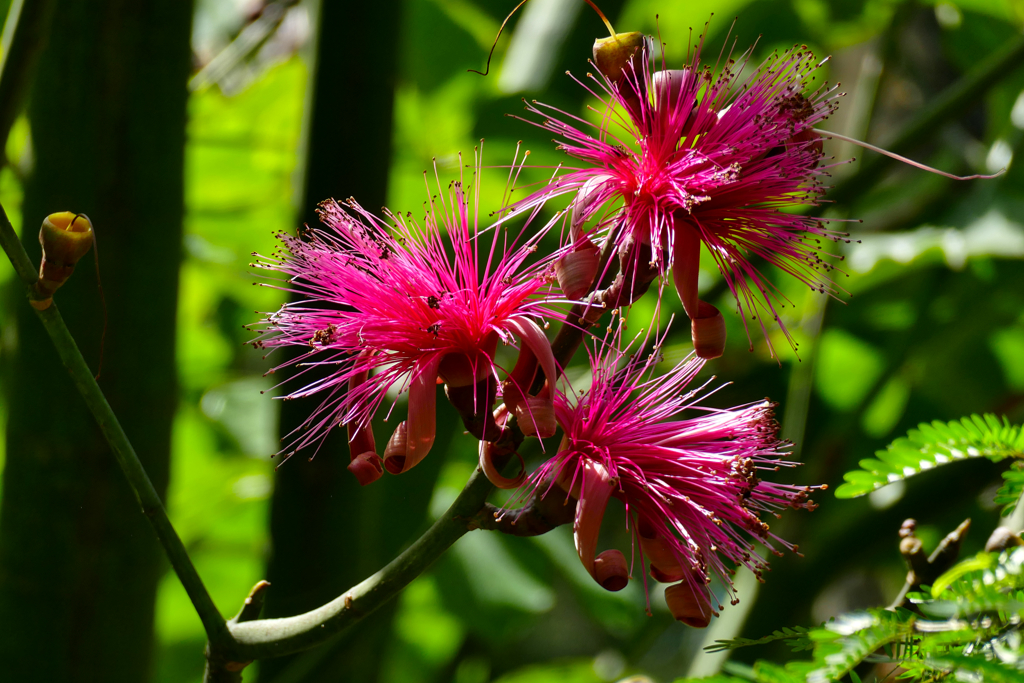
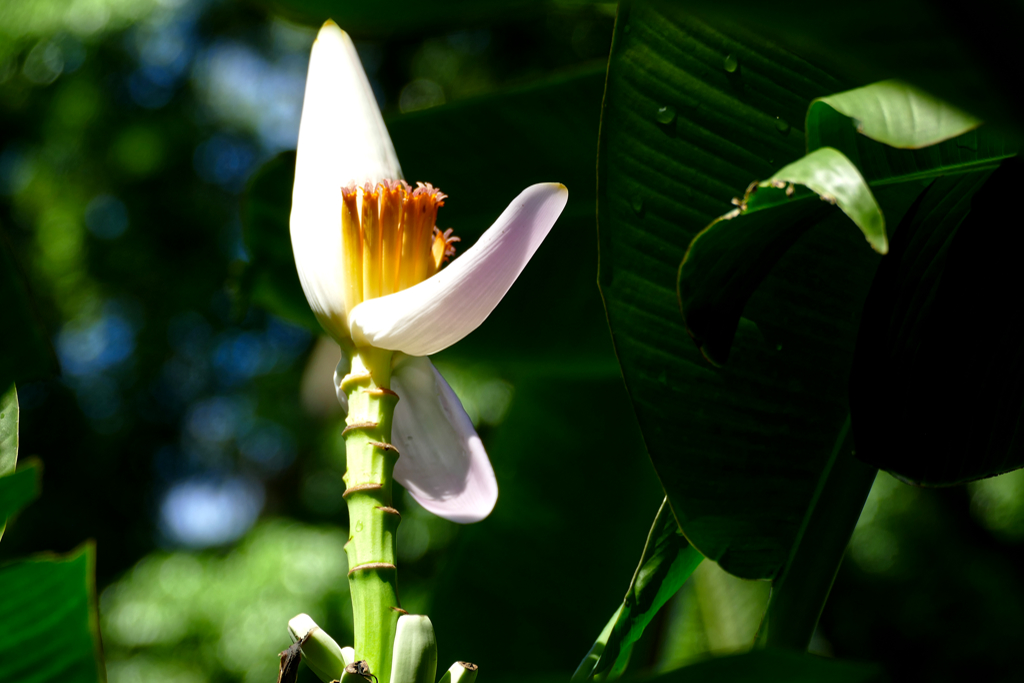
The park aims to reflect the richness of the flora of the Antilles. An approximately 1.5-kilometer-long path winds through fifteen different themed sections. There is an arboretum, a water lily pond, orchids, cacti, and much more. There is also an artificial waterfall next to a flamingo pen and, in my opinion, a completely pointless and even quite sad aviary. I think they could have limited themselves to the flora and left the fauna out.
The gardens are open every day from 9 a.m. to 4.30 p.m., and the admission fee is a whopping €uro 17.50
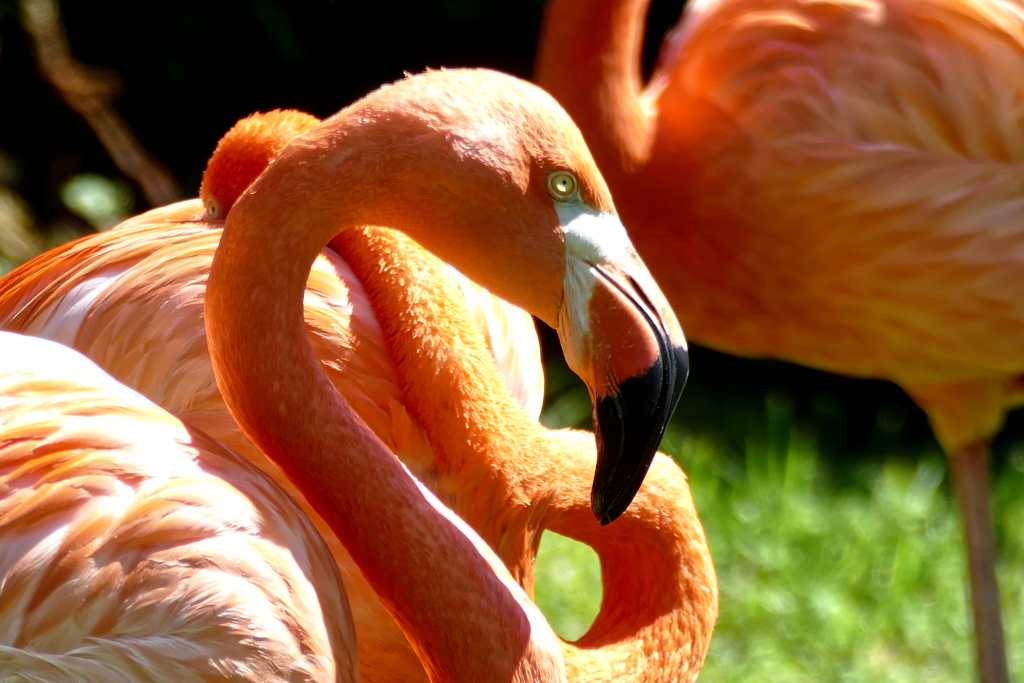
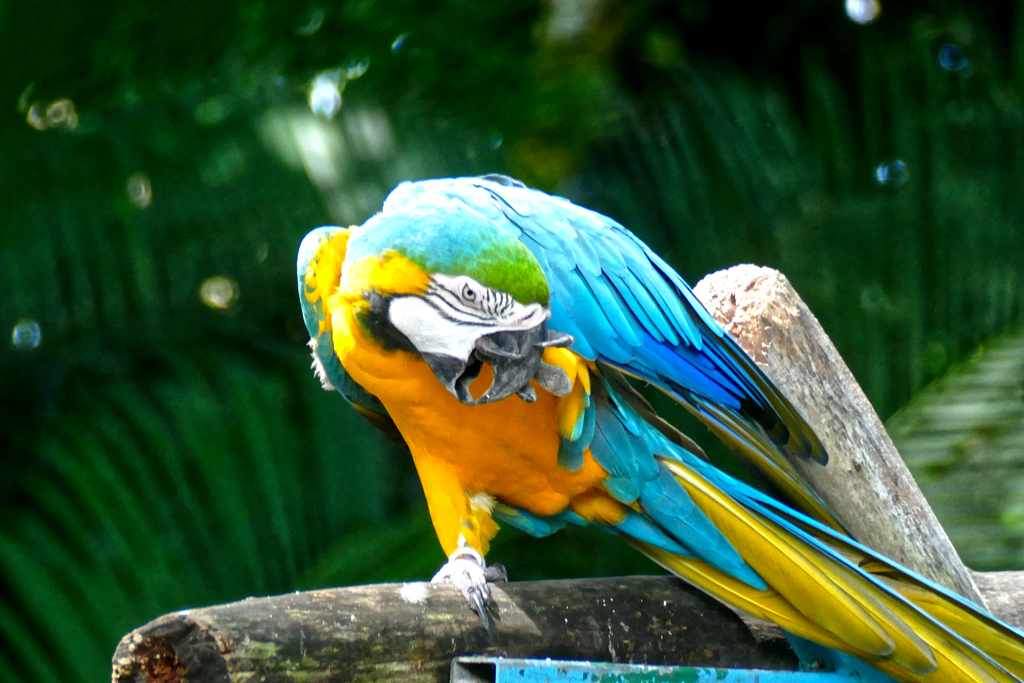
You can have lunch at their panoramic restaurant from 12 p.m. to 2.30 p.m. or grab a quick bite at the snack bar between 10 a.m. and 5 p.m.
My Tip:
Next to the garden is Coluche’s former home. This villa was recently renovated and is now a luxurious holiday home. Apart from the fact that you can spend your vacation in a French legend’s former home, you’ll enjoy beautifully decorated rooms, impeccable service, an outdoor pool, and a garden overlooking the entire bay. A picture is worth a thousand words, and therefore you’ll see the property in this post’s cover photo. If this tickles your fancy, check out the villa’s availability and rates.*
Plage de la Grande Anse
Only about two and a half kilometers north of Deshaies is one of Guadeloupe’s most popular beaches, the Plage de Grande Anse. Be careful when googling: Since “Grande” translates to “big” and “Anse” translates to “bay,” countless places with that name will pop up. So you better specify that you are looking for Plage de Grande Anse Deshaies.
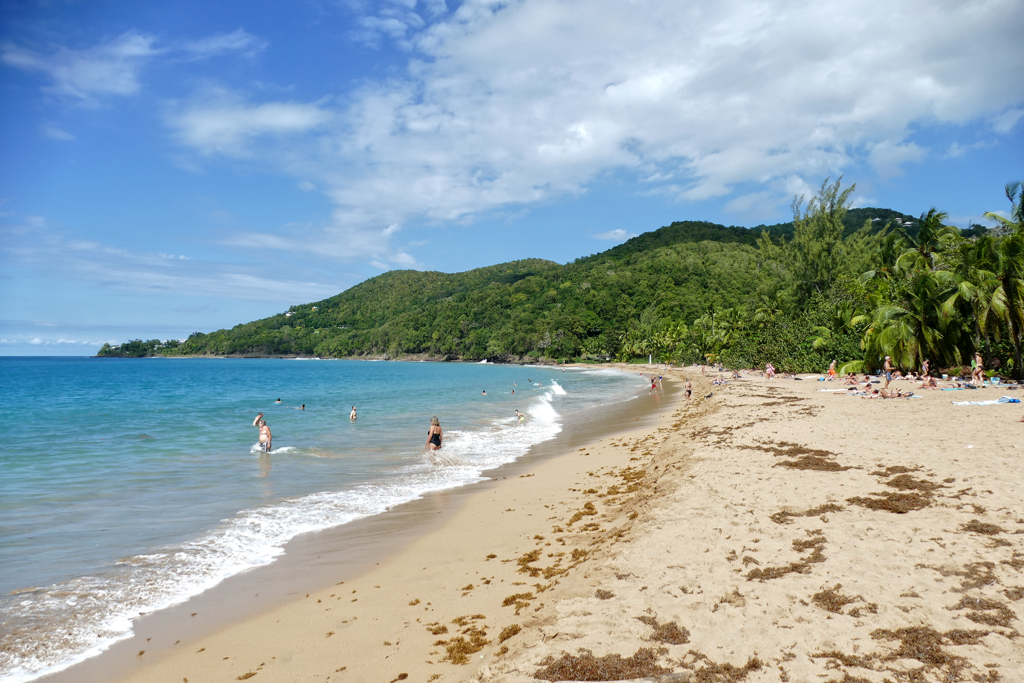
It is said to be one of the most beautiful beaches in Guadeloupe. In fact, it is a long strip of golden sand that borders the turquoise water in a crescent shape.
A huge plus is the lush vegetation. This way, every visitor finds a lovely spot in the shade. Behind this green strip of palm trees and sea grapes is a spacious parking lot where some vendors also offer handicrafts, snacks, and drinks. After a tour of Deshaies and an extensive visit to the botanical garden, there is nothing better than a relaxing sunbath and a refreshing swim in the tropical setting of Grande Anse.
Although I enjoyed my relaxing stay at Plage de la Grande Anse, it’s not at the top of my list. To make it there, the beach shouldn’t have been so incredibly crowded. I was there on a weekday and I can’t even imagine what it must be like on weekends.
Therefore, in my opinion, the bay cannot compete with the bright white sands of Grand Terre’s beaches. But that’s criticism at an extremely high level and I really enjoyed the few hours there despite these tiny flaws.
Let’s Go!
If there is one thing that I and the bus drivers in Guadeloupe have in common, it is über-punctuality. Whether it’s the train station or the airport, I always get there on time – some say too early. Now these people will have to change their attitude in Guadeloupe.
The buses there run according to fixed timetables. Regardless, due to the long distances, real times depend heavily on the current traffic situation, more so than in the city center area. This means that the bus can arrive ten minutes later during rush hour. Unfortunately, this also means that he gets there a little earlier when the roads are clear. The drivers don’t spend the extra time waiting at stops. They keep driving.
Especially in Basse Terre, there are rarely congested roads. So the buses get through excellently and are very early. When I was waiting for the bus at the Plage de la Grande Anse stop, the coach arrived an incredible twenty minutes before the scheduled time. So those who were at the stop on time missed it.
Even if the beach is so comfortable, go to the bus stop very early. I have listed this and six other crucial tips below so that traveling by bus will be as easy for you as it was for me.
How to Get Around
Contrary to all claims, the bus network in Guadeloupe is, generally speaking, quite well-developed. I can’t think of any place that doesn’t have any bus service at all. What makes things a bit confusing at first is that two different companies are operating completely independently.
Firstly, the company Karu’lis serves the city and district around Pointe-à-Pitre as well as the southern coast of Grand Terre. Their buses are easily recognizable as they are bright orange. You find lines, maps, schedules, and fares online on their website as well as on the Karu’lis App. There you can also charge money and pay for your tickets as you go. Otherwise, you can buy your ticket just as easily from the driver.
If you want to go to the northern area of Grand Terre or to Basse Terre, you need to take a bus that’s operated by a different company. This being said, keep in mind that Karu’lis’ coaches are going to the Gare De Darboussier east of Pointe-à-Pitre’s harbor basin while all the other buses are leaving from the Gare Routière de Bergevin located close to the cruise terminal. These terminals are about a 20-minute walk from each other, so take that into consideration when planning your trip.
Most importantly, don’t look for the Bergevin terminal on Google Maps as they will send you to a roundabout about twenty minutes north of the proper spot.
Believe me, been there, done that.
Obviously, you’ll find the correct location in the map I created below.
Do Your Research
While the bus company serving Basse Terre is at least as good and reliable as Karu’lis, it has two major flaws: Firstly, there is no App, you have to get all the info online. Fortunately, they have an excellent website where you find a system map and all timetables as comfortably downloadable PDFs. All you have to do is check on their map which bus goes where and then look up the times on the respective schedule. Everything is marked in bright colors and sounds probably more complicated than it is.
To make things easier for you, I’m linking here to the timetables of bus #105 which is going from Pointe-à-Pitre to the town of Basse Terre as well as #103 going to Deshaies. #115 crosses the Route de la Traversée, and #113 goes up and down the west coast connecting Basse Terre with Deshaies. Obviously, you’ll find these and all the other lines on their website.
I actually recommend printing out all the schedules before your trip and taking them with you to Guadeloupe.
Don’t worry, there aren’t that many.
The bigger problem is that Basse Terre’s bus routes aren’t on Google Maps. So while you can look up the bus from Pointe-à-Pitre to Sainte Anne on Google Maps just like you’d look for a connection in Paris or London, you cannot do that for buses in Basse Terre.
This does not mean they are less reliable, you only have to check all your connections on their website.
Seven Tips For Exploring Guadeloupe By Public Bus
- The most important tip to make your bus ride at least tolerable: Do consider the passage a valid part of the whole experience.
If you consider your bus ride a wasted period of time between two meaningful activities, you’ll get mad. Think of it as an original tour in an authentic vehicle: Look out the window and enjoy the amazing scenery, the turquoise waters, the endless sugarcane fields, the swaying palm trees. Try to get a good glimpse of the towns and villages. Watch passengers getting on and off, see what they are wearing, what they are carrying.
This is neither New York nor Paris nor Tokyo, this is a Caribbean island, and the bus ride is part of the whole experience. So do yourself a favor, reset your watch, lean back, and go where and when the bus takes you.
————————————— - Don’t plan too much for one day. One or two destinations will be enough. Yes, in cities like London or Berlin, you can design a meticulous program for the day and follow through. Taking a day trip on public buses in Guadeloupe is more complex and at times also tiring: you’ll be walking quite a bit, you’ll have to carry all sorts of stuff with you, you’ll have to plan for longer waiting times, and all this in the tropical heat. Believe me: Less is definitely more.
————————————— - However, plan your trip as thoroughly as possible in advance by checking and downloading the timetables from the Région Guadeloupe’s website as well as Karu’lis’ website and by checking connections on Google Maps or the Karu’lis App wherever possible.
————————————— - Be at the stop at least ten, better 20 minutes before the scheduled time as coaches tend to arrive far too early.
————————————— - While waiting, don’t get distracted by reading or chatting with others. Keep your eyes on the road if the bus is coming. Because if you just hang around at the bus stop, the driver won’t consider you a potential passenger and might just merrily pass you by. As soon as you see the bus approaching, give the driver a sign by lifting your arm or waving.
————————————— - Make sure to have small change to pay your fare as the drivers accept only bills up to 10 €uros. Trips cost between 1.80 €uros and 5 €uros depending on the distance.
————————————— - Never rely on the last possible connection or the latest scheduled coach. Plan your trip in a way that you can take at least one later bus.
—————————————
Organized Trips
As I pointed out, most of Guadeloupe’s wonderful places can be reached by public bus. However, this will cost you some time and possibly a lot of nerves. Hence, an organized tour might be a more suitable option, especially if you don’t have much time on the island. Also, if you want to visit the smaller islands, and engage in activities on the water like sailing or snorkeling from a boat, you have to go on a tour unless you bring your own yacht. Therefore, here are some great tours to choose from*:
Where to Stay
All things considered, your lodging choice should primarily depend on what you are planning on doing. Also, you are obviously more flexible if you’re renting a car which I didn’t.
If you are planning on spending most of the time on Guadeloupe’s marvelous beaches, you’ll probably opt for a town with a Plage du Bourg, a city beach. There are dreamy beaches on Grand Terre as well as on Basse Terre, albeit, those on the latter one are more difficult to reach by public bus. Since I definitely recommend exploring both parts of the island, it can be more convenient to choose your accommodation accordingly, hence, to stay a couple of days in Grand Terre and then move to Basse Terre.
Booking.comAs for me, I wanted to be within walking distance of a beautiful beach. At the same time, I wanted to be close to the public bus system. Therefore, renting an apartment at Chez Janou* in Grand Terre was the perfect choice.
At the end of the day, it totally depends on your preferences and your budget if you choose a luxurious room at a fancy resort or if you go for a cozy apartment rented out by a local. Either way, you can check out the availability and prices of various lodging options in Basse Terre on this map*:
Booking.comWhat to Eat
Caribbean cuisine combines the culinary traditions of all the peoples who have lived in the region. That sounds like a pleasant mix of cultures, but we all know how this often involuntary migration came about. Whatever the case, Creole cuisine is a vibrant mix of African, French, and Asian dishes. It combines lots of spices and different flavors.
Guadeloupeans, however, seem to be very much into snacks’n’starters. The most famous dish is actually a fried sandwich stuffed with whatever your heart’n’stomach desires. The second favorite one is Agoulou. It is a quite large brioche bread filled with a wide variety of fillings.
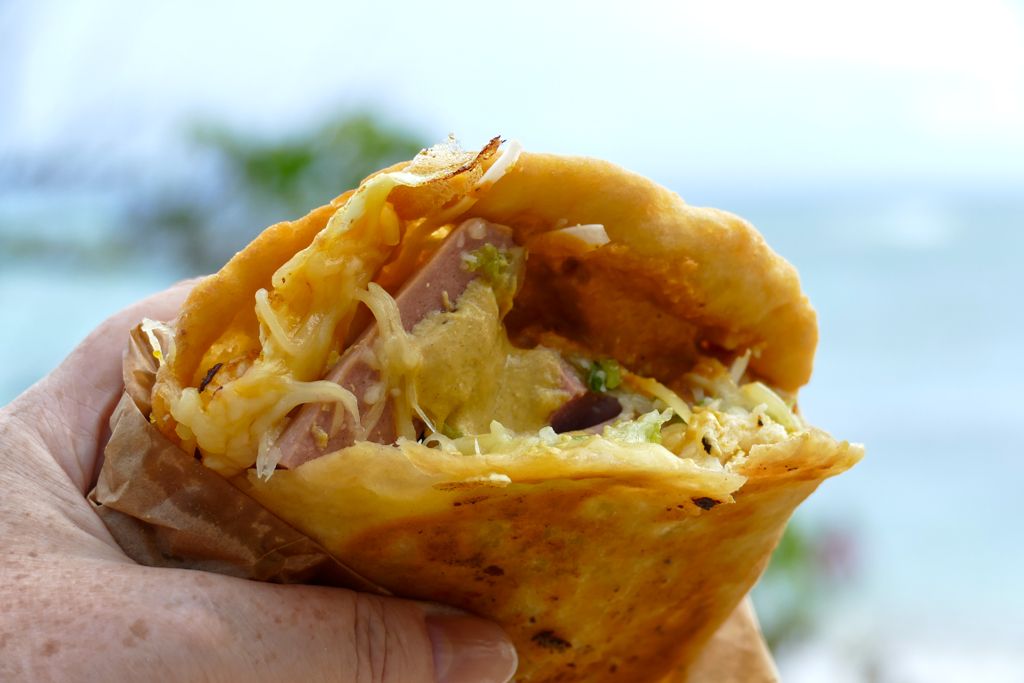
A must-try starter is Accras, small fritters with cod, shrimp, or vegetables. You know that the cook knows his trade when they are crispy on the outside, yet inside still soft and creamy. Other popular starters are stuffed crabs and boudin, a local sausage. There are various kinds like the one made of bacon and pig’s blood or an even more exotic one made from seafood. Many restaurants offer varied starters in one platter to try.
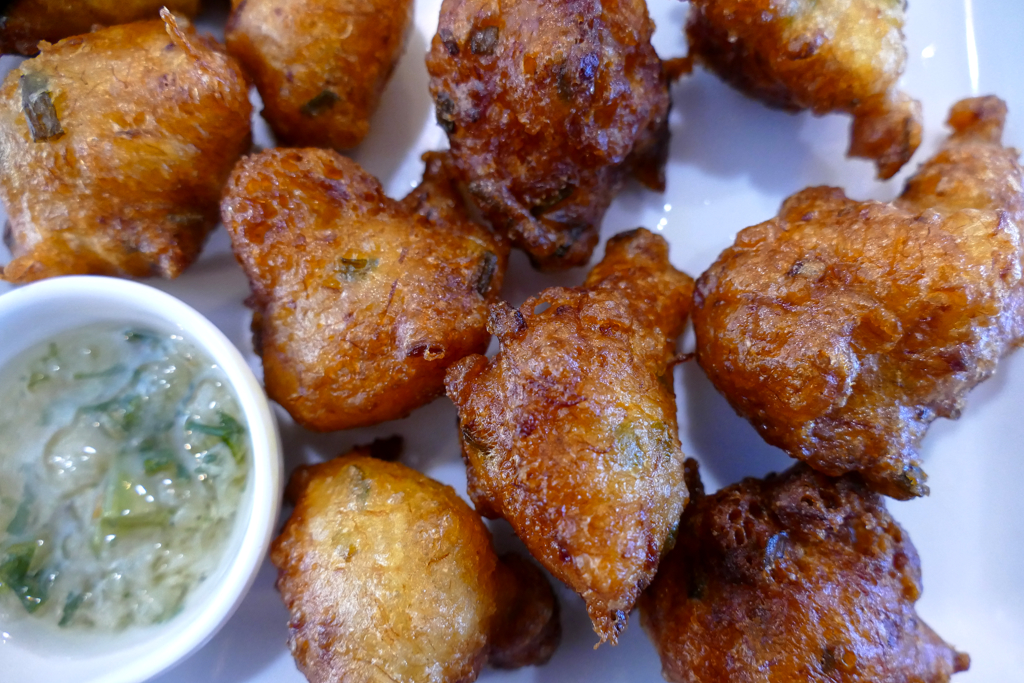
Now let’s continue with the most iconic main courses. Obviously, there is lots of fish and seafood, we are talking about an island, after all. But the traditional cuisine also includes meats, mostly chicken. It can be grilled on charcoal in cut-open barrels or smothered in a spicy curry sauce called Colombo, to name just two variations.
Quick Snacks
Obviously, you can eat at many classic restaurants. However, don’t underestimate the many fast food eateries and Rôtisseries that you’ll find in towns’n’villages. Albeit, the term fast food is misleading since these snack bars cook their delicacies actually with lots of love and time before they keep them hot on a counter so you can grab a quick lunch. A downside might be that you can enjoy these delicious meals solely at lunchtime.
One good thing about French influence is the countless bakeries that you find in every town and even the smallest village. Baguette, croissants, pain au chocolat, chausson aux pomme that literally melt in your mouth. Yes, just like in France. There are also quiches, puff pastries filled with minced meat, and juicy sandwiches. In any case, your snack for the beach day is ready and waiting for you at your local boulangerie!
Finally, don’t forget to stock up on fresh fruits. You’ll be amazed how much better they taste if they just fell from a tree instead of travelling thousands of miles to your local supermarket!
For stories and information on other parts of Guadeloupe, check out my posts
Best Places to Visit in Grand Terre, the Eastern Wing of GUADELOUPE (also by public bus)
Guadeloupe: What Not to Miss on a Visit to the Island of Marie Galante
The Best Beaches in Guadeloupe You Can Easily Visit by Public Bus
Best Street Art in GUADELOUPE
For general information on the island of Guadeloupe, go to the main post
Grand GUADELOUPE: Complete Guide And Perfect Itineraries (also for travels by public bus)
There, you’ll find comprehensive information and tips that will make your trip much smoother and more enjoyable.
Map
On this map, you can see where all the mesmerizing places I’m introducing in this post are located.
Clicking on the slider symbol at the top left or the full-screen icon at the top right will display the whole map including the legend.
Pinnable Pictures
If you choose to pin this post for later, please use one of these pictures:
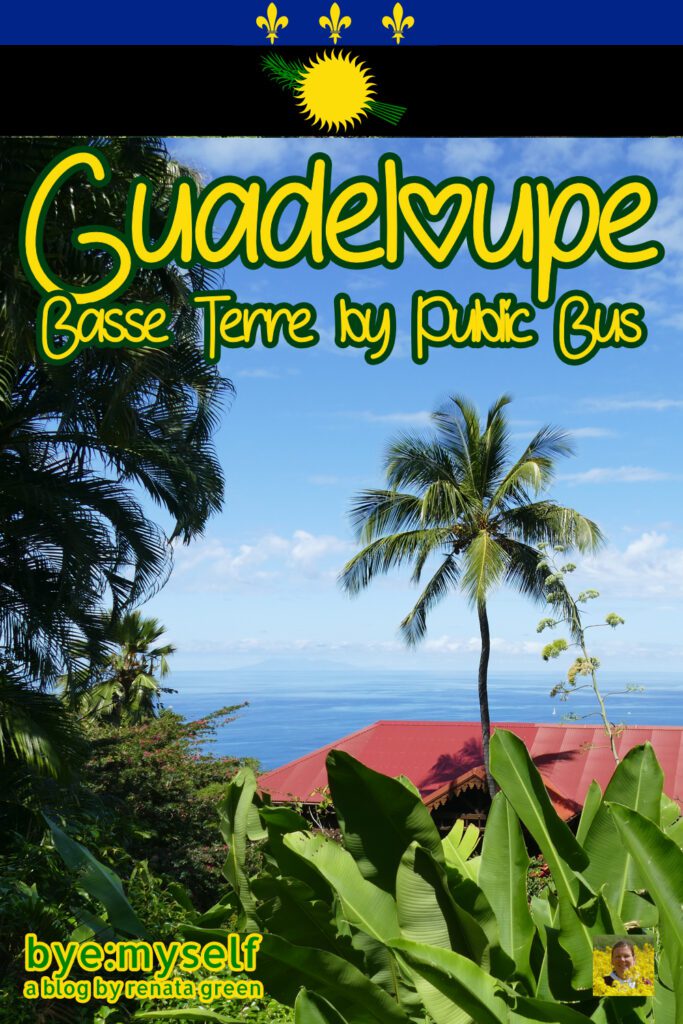
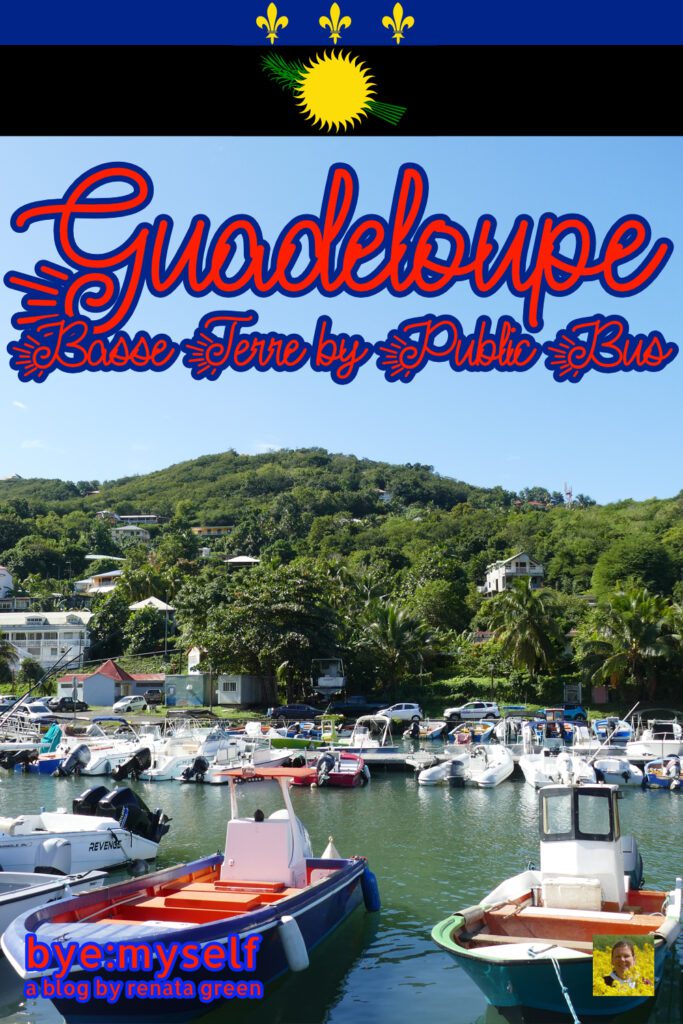
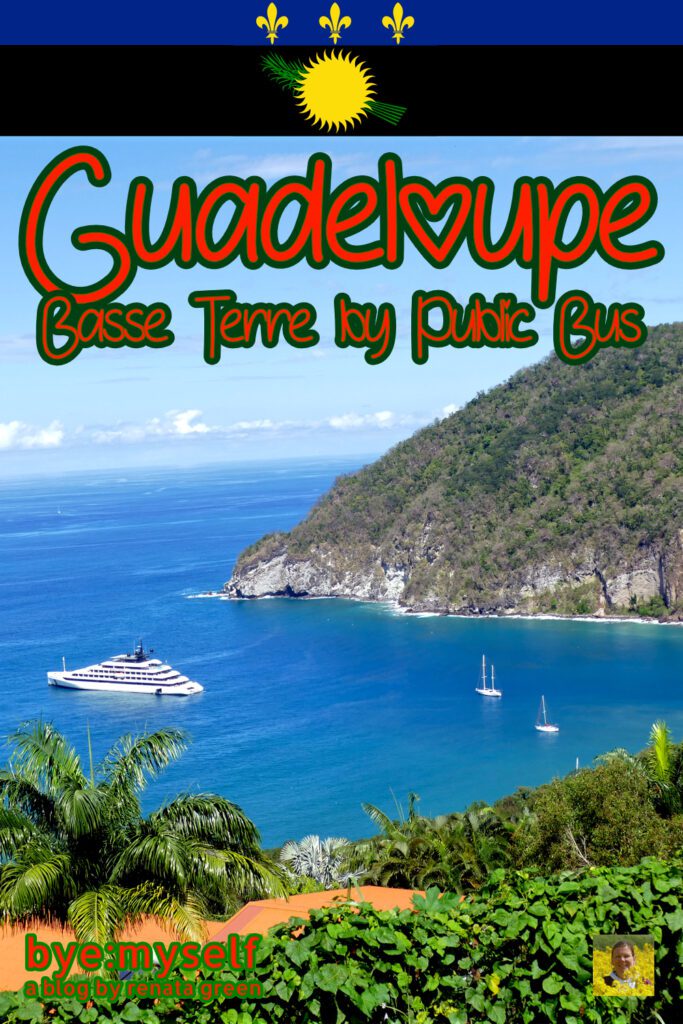
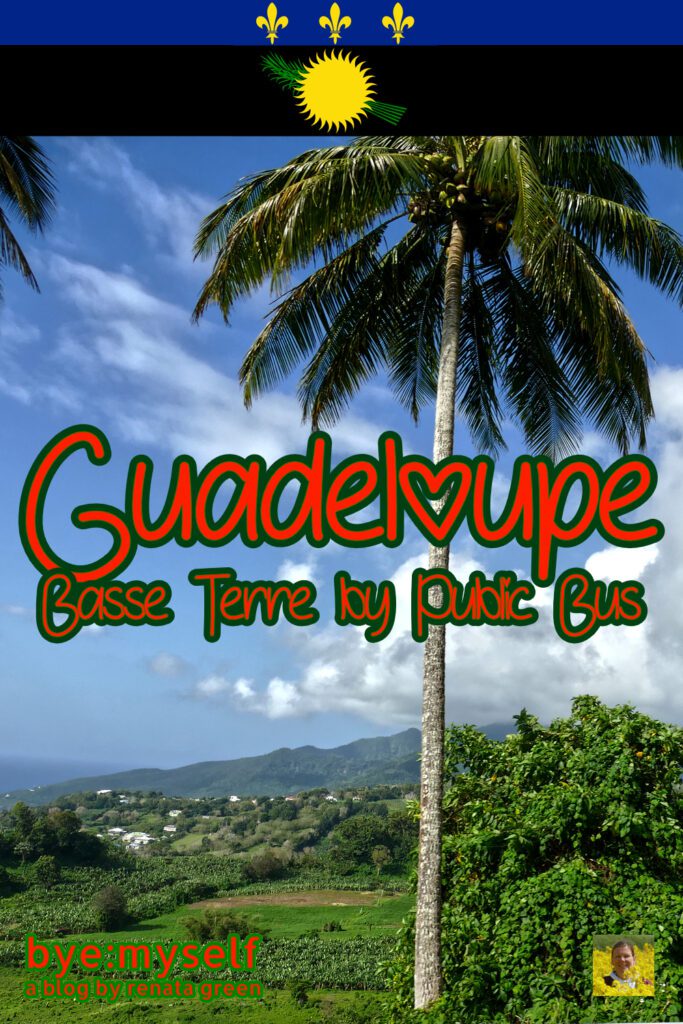
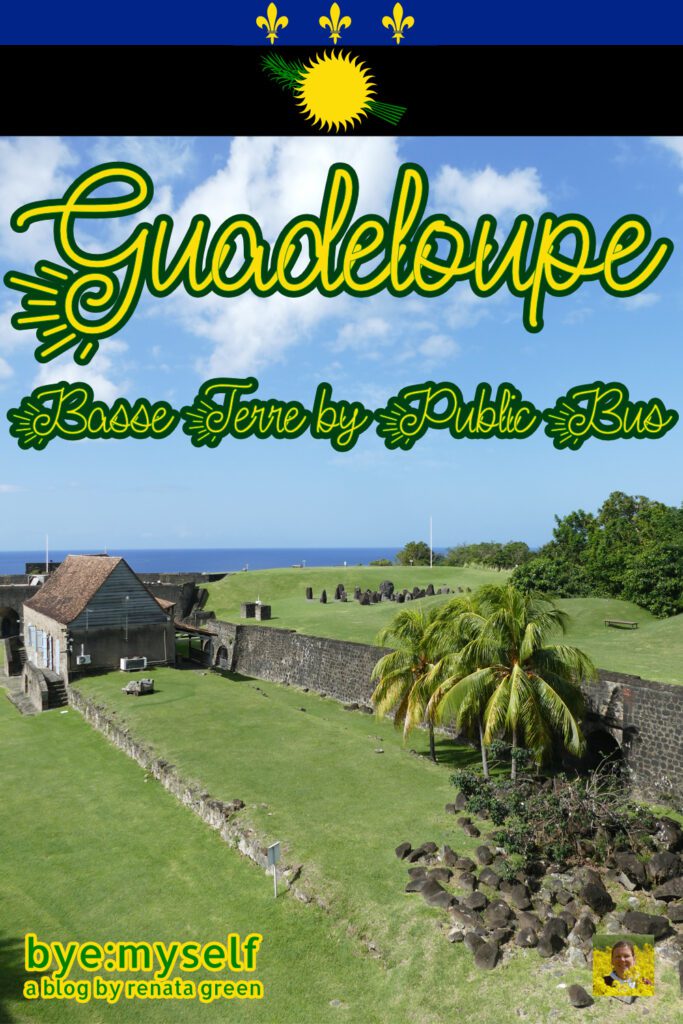
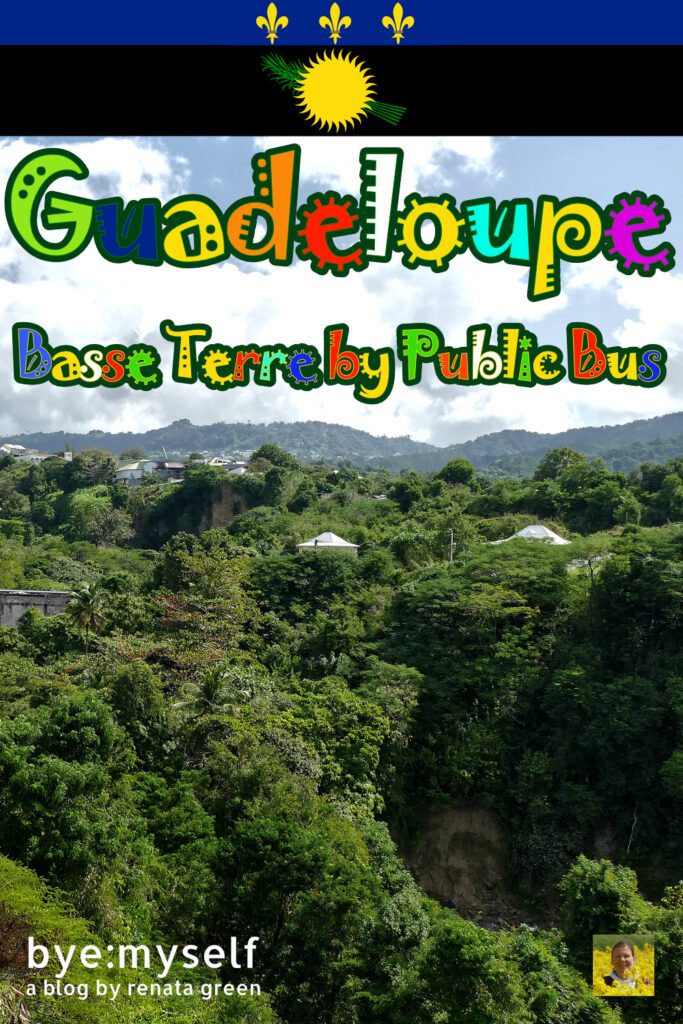
Did You Enjoy This Post? Then You Might Like Also These:
Guide to CIENFUEGOS – the Fancy Side of Cuba
Best Street Art in GUADELOUPE
Guide to TRINIDAD – Cuba’s Colonial Fantasy
What Not to Miss in ARUBA, the Caribbean A-Lister
One Week in BONAIRE: The Best Activities Beyond Diving
Guide to HAVANA – Welcome to the Club
Carnival 2024: Floats’N’Festivities on ARUBA, BONAIRE, and CURACAO
Guide to SANTA CLARA – Reliving Cuba ‘s History
* This is an affiliate link. If you book through this page, not only do you get the best deal. I also get a small commission that helps me run this blog. Thank you so much for supporting me!
